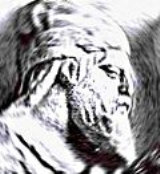
List of Ukrainian rulers
Encyclopedia
For over 7000 years Ukraine has been a living space
for many cultures and nations.
 This list encompasses all rulers and leaders on Ukrainian territory, from ancient to modern times. It includes only local rulers whose seat of power was located in the modern Ukraine
This list encompasses all rulers and leaders on Ukrainian territory, from ancient to modern times. It includes only local rulers whose seat of power was located in the modern Ukraine
and only the rulers whose power was derived directly from the people of Ukraine at the time, and does not include the governors who received their authority from some foreign powers (as during Lithuanian
, Polish
, Hungarian
, Austrian
, and Russian
overlordship).
This is not a list of sovereigns. Throughout its history Ukraine had various forms of governance
from monarchies to democratic republics.
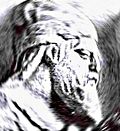 Scythia
Scythia
was a loose state that originated as early as 8th century BC. Little is known of them and their rulers. Most detailed description came down to us from Herodotus
.
 The shores of Crimea
The shores of Crimea
were settled by Greeks since the 7th century BC. The kingdom
was established around 480 BC. It was ruled by three consecutive dynasties: Archaeanactidae (480 BC – 438 BC), Spartocids (438 BC – 108 BC), and Pontids (108 BC – 16 BC). After Pontids the territory became a Roman client kingdom.
Pontids
the The Great Migration Period
kicked off with the descent of the Goths
from the Baltic region into Ukraine, about AD 200. They either took over or assimilated with the local Slavic tribes. The Goths were in turn pushed out by aggressively encroaching Huns
, about 375. The Goths went on to conquer Southern Europe
and the Huns moved to the Balkans and created a Hunnic Empire
which lasted for a hundred years. After splitting of the Empire, some of the Huns moved back north in the territories of Ukraine and formed Patria Onoguria, now known as Old Great Bulgaria
. In the 7th century Onoguria largely defected to Khazaria – an expanding Turkic state centered in the North Caucuses which controlled the Eurasian steppe until the 9th century.
-Vesi and Greuthungi
-Ostrogothi) is first attested in 291.
Tervingi
The Balti dynasty
, Balth(e)s, Baltungs, or Balthings, existed among the Tervingi
("forest people"), called later the Visigothi. The names of the Drevlyans
and the Gothic Tervingi in Ukraine have often been adduced as parallels to agac-ari ("forest men" in Turkic).
Greuthungi
The Amali dynasty, Amals, Amaler, or Amalings of the Greuthungi
("steppe dwellers" or "people of the pebbly coasts"), called later the Ostrogothi.
by the Sabirs who in turn were being attacked. Its 7th century period is commonly referred to as Old Great Bulgaria
(~600–~690).
Rulers of Kiev and Kievan Rus'
were descendants of Rurik I
, a Varangian
pagan konung or chieftain, who was of Finno-Ugrian
origin (haplogroup N1c1
).
in 1097 Kievan Rus'
entered a feudal period and was divided into principalities ruled by the Rurikid family princes who were in a constant power struggle with each other. Major principalities were: Galicia-Volhynia, Kiev, Chernigiv, and Pereyaslavl
. In the period of 1240–1362, the three latter ones were forced to accept the Golden Horde
overlordship.

(Ukrainian) state in Galicia and Volhynia
. Depending on the title of the ruler it was called either principality or kingdom. The first king, Coloman of Galicia-Lodomeria, was crowned in 1215, although the first nominal king of Galicia was Andrew II of Hungary
, the son of Béla III of Hungary
, who reigned from 1188 to 1190.
In 1349, Liubartas lost all territories, except for eastern Volhynia, to Casimir III of Poland
. In 1366, a Polish-Lithuanian treaty was signed: eastern Volhynia with Lutsk retained under Liubartas' rule (the Grand Duchy of Lithuania
), while Galicia, western Volhynia, and western Podolia were annexed by the Crown of the Kingdom of Poland.
In early 1320s, a Lithuanian army led by Gediminas defeated a Slavic army led by Stanislav of Kiev at the Battle on the Irpen' River
, and conquered the city. The Tatars, who also claimed Kiev, retaliated in 1324–1325, so while Kiev was ruled by a Lithuanian prince, it had to pay a tribute to the Golden Horde
. Finally, as a result of the Battle of Blue Waters
in 1362, Kiev and surrounding areas were incorporated into the Grand Duchy of Lithuania by Algirdas
, Grand Duke of Lithuania.
Voivodes of Kiev
When the Polish-Lithuanian Commonwealth
was formed by the Union of Lublin
in 1569, Kiev
and surrounding areas, Podolia
, Volhynia
, and Podlaskie, as the Kiev Voivodeship, Bratslav Voivodeship, Volhynian Voivodeship, and Podlaskie Voivodeship
, were transferred from Lithuania to Poland.
were not of the Ukrainian ethnos
. Their Crimean Khanate
ruled a large part of modern Ukraine
, with a capital at Bakhchisaray
.
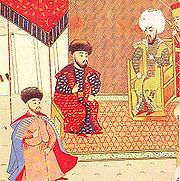
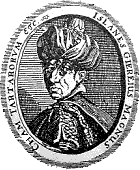
† The reigns of Canibek Giray in 1624 and of Maqsud Giray in 1771–1772 are not listed. Though these khans were formally appointed by Ottoman
sultans they did not reach the throne and did not rule Crimea
. In the years mentioned, the authority in the Crimean Khanate
was exercised by Mehmed III Giray and Sahib II Giray correspondingly.
The nominal khans Şahbaz Giray (1787–1789) and Baht Giray (1789–1792) mentioned in some works are not listed in this table as they did not rule the Crimean Khanate annexed by Russian Empire
in 1783.
was a military and civil leader, democratically elected by the Cossack
s.
at this time that were largely independent of each other, so some of the Hetmans'
tenures overlap.
a new Cossack republic, the Hetmanate
, was formed.
(1660–1687) was a time in Ukrainian history when the country fell into disarray and chaos. Afterwards, the Cossack state emerged as a vassal of the Russian Empire
. During this period a number of hetmans stayed in power for short periods of time and often controlled only parts of the country. Moreover the Treaty of Andrusovo
(1667) split the Cossack Hetmanate
along the Dnieper River
into Left-bank Ukraine
, which enjoyed a degree of autonomy within the Tsardom of Russia
; and Right-bank Ukraine
which remained part of the Polish-Lithuanian Commonwealth
, at times (1672–1699) occupied by the Ottoman Empire
.
Hetmans of Right-bank Ukraine
Hetmans of Left-bank Ukraine
, a new Malorossiyan
collegium was established in 1764, and the Zaporozhian Host
was disbanded in 1775. As a result of the second and third Partitions of Poland
in 1793 and 1795, eastern and central parts of Ukraine were incorporated directly into the Russian Empire
. Western Ukraine was annexed into the Habsburg Monarchy
earlier, in the following order: Carpathian Ruthenia
(1526), Galicia (1772), and Bukovina
(1775).
The Russian Empire existed until 1917, and the Dual Monarchy, Austria–Hungary, existed until 1918.
(UNR, 1917–1921) was formed after the Russian Revolution of 1917
, and lasted until the Peace of Riga
between Poland
and Soviet Russia in March 1921. The leadership title varied and, despite a rather widespread misconception, none of them had the official title of president.
was a provisional council of the UNR formed after Skoropadskyi's Hetmanate fell apart. On 22 January 1919, the Act of Unification
of the Ukrainian People's Republic
and the West Ukrainian People's Republic was passed. The text of the universal was made by the members of the Directory.
on 22 January 1919, although it was mostly a symbolic act while the western Ukrainians retained their own Ukrainian Galician Army
and government structure. After the Polish-Ukrainian War
(1918–1919), Poland took over most of territory of the West Ukrainian People's Republic by July 1919. Since November 1919, the government of the WUNR was in exile.
Secretaries of the Central Committee of the Communist Party (Bolsheviks) of Ukraine
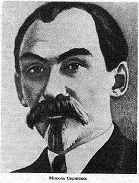
First Secretary of the Central Committee
Executive Secretary of the Central Committee
First Secretaries of the Communist Party
General Secretaries of the Central Committee
First Secretaries of the Central Committee

Ukraine
On 5 July 1991, the Verkhovna Rada
of the Ukrainian SSR passed a law establishing the post of the President of the Ukrainian SSR. The title was changed to the President of Ukraine upon the proclamation of independence (24 August 1991). The first election of the President of Ukraine was held on 1 December 1991.
History of Ukraine
The territory of Ukraine was a key center of East Slavic culture in the Middle Ages, before being divided between a variety of powers. However, the history of Ukraine dates back many thousands of years. The territory has been settled continuously since at least 5000 BC, and is also a candidate site...
for many cultures and nations.

Ukraine
Ukraine is a country in Eastern Europe. It has an area of 603,628 km², making it the second largest contiguous country on the European continent, after Russia...
and only the rulers whose power was derived directly from the people of Ukraine at the time, and does not include the governors who received their authority from some foreign powers (as during Lithuanian
Grand Duchy of Lithuania
The Grand Duchy of Lithuania was a European state from the 12th /13th century until 1569 and then as a constituent part of Polish-Lithuanian Commonwealth until 1791 when Constitution of May 3, 1791 abolished it in favor of unitary state. It was founded by the Lithuanians, one of the polytheistic...
, Polish
Polish-Lithuanian Commonwealth
The Polish–Lithuanian Commonwealth was a dualistic state of Poland and Lithuania ruled by a common monarch. It was the largest and one of the most populous countries of 16th- and 17th‑century Europe with some and a multi-ethnic population of 11 million at its peak in the early 17th century...
, Hungarian
Kingdom of Hungary
The Kingdom of Hungary comprised present-day Hungary, Slovakia and Croatia , Transylvania , Carpatho Ruthenia , Vojvodina , Burgenland , and other smaller territories surrounding present-day Hungary's borders...
, Austrian
Austrian Empire
The Austrian Empire was a modern era successor empire, which was centered on what is today's Austria and which officially lasted from 1804 to 1867. It was followed by the Empire of Austria-Hungary, whose proclamation was a diplomatic move that elevated Hungary's status within the Austrian Empire...
, and Russian
Russian Empire
The Russian Empire was a state that existed from 1721 until the Russian Revolution of 1917. It was the successor to the Tsardom of Russia and the predecessor of the Soviet Union...
overlordship).
This is not a list of sovereigns. Throughout its history Ukraine had various forms of governance
Governance
Governance is the act of governing. It relates to decisions that define expectations, grant power, or verify performance. It consists of either a separate process or part of management or leadership processes...
from monarchies to democratic republics.
Scythian kings

Scythia
In antiquity, Scythian or Scyths were terms used by the Greeks to refer to certain Iranian groups of horse-riding nomadic pastoralists who dwelt on the Pontic-Caspian steppe...
was a loose state that originated as early as 8th century BC. Little is known of them and their rulers. Most detailed description came down to us from Herodotus
Herodotus
Herodotus was an ancient Greek historian who was born in Halicarnassus, Caria and lived in the 5th century BC . He has been called the "Father of History", and was the first historian known to collect his materials systematically, test their accuracy to a certain extent and arrange them in a...
.
- ScylasScylasScylas - , the Scythian king 5. BC. e, the heir and son king Ariapifa. Her mother taught her son the Greek language and literacy...
aka Skyles or Skylla (ca. 500 BC – ca. 450 BC) – HerodotusHerodotusHerodotus was an ancient Greek historian who was born in Halicarnassus, Caria and lived in the 5th century BC . He has been called the "Father of History", and was the first historian known to collect his materials systematically, test their accuracy to a certain extent and arrange them in a...
describes him as a Scythian whose mother was Greek, he was expelled by his people - OctamasadasOctamasadasOctamasadas was a Scythian king, the son of King Ariapifa, who lived around 446 BC. He came to power after the assassination of his brother Scylas....
aka Oktamasades (ca. 450 BC) - Opoino, Queen of Scythia (ca. 430 BC) – married Ateas the Thataean, a Greek prince
- AteasAteasAteas was described in Greek and Roman sources as the most powerful king of Scythia, who lost his life and empire in the conflict with Philip II of Macedon in 339 BC...
the Thataean (ca. 429 BC – 339 BC) – defeated by the MacedoniansAncient MacedoniansThe Macedonians originated from inhabitants of the northeastern part of the Greek peninsula, in the alluvial plain around the rivers Haliacmon and lower Axios...
; his empire fell apart - Aripharnes aka Arypharnasha the Thataean (ca. 339 BC – ca. 310)
- Sagillus (ca. 250 BC)
- Saitapharnes (ca. 175 BC)
- Akrossa (ca. 150 BC)
- Akrosandros (ca. 125 BC)
- SkilurusSkilurusSkilurus or Scylurus was the best known king of Scythia in the 2nd century BC. He was the son of a king and the father of a king, but the relation of his dynasty to the previous one is disputed...
aka Skylurus (ca. 110 BC) – deposed ca. 100 BC by the SarmatiansSarmatiansThe Iron Age Sarmatians were an Iranian people in Classical Antiquity, flourishing from about the 5th century BC to the 4th century AD.... - PalacusPalacusPalacus or Palakus was the king of Lesser Scythia who succeeded his father, Skilurus. Resuming the latter's war against Mithridates the Great, he attempted to besiege Chersonesos but was defeated by Pontic forces under Diophantus. Enlisting the assistance of the Rhoxolani under Tasius, Palacus...
aka Palakus (ca. 100 BC) – the last Scythian ruler, defeated by Mithridates VI of PontusMithridates VI of PontusMithridates VI or Mithradates VI Mithradates , from Old Persian Mithradatha, "gift of Mithra"; 134 BC – 63 BC, also known as Mithradates the Great and Eupator Dionysius, was king of Pontus and Armenia Minor in northern Anatolia from about 120 BC to 63 BC...
Kings of Cimmerian Bosporus

Crimea
Crimea , or the Autonomous Republic of Crimea , is a sub-national unit, an autonomous republic, of Ukraine. It is located on the northern coast of the Black Sea, occupying a peninsula of the same name...
were settled by Greeks since the 7th century BC. The kingdom
Bosporan Kingdom
The Bosporan Kingdom or the Kingdom of the Cimmerian Bosporus was an ancient state, located in eastern Crimea and the Taman Peninsula on the shores of the Cimmerian Bosporus...
was established around 480 BC. It was ruled by three consecutive dynasties: Archaeanactidae (480 BC – 438 BC), Spartocids (438 BC – 108 BC), and Pontids (108 BC – 16 BC). After Pontids the territory became a Roman client kingdom.
Pontids
- Mithridates VI of PontusMithridates VI of PontusMithridates VI or Mithradates VI Mithradates , from Old Persian Mithradatha, "gift of Mithra"; 134 BC – 63 BC, also known as Mithradates the Great and Eupator Dionysius, was king of Pontus and Armenia Minor in northern Anatolia from about 120 BC to 63 BC...
(108 BC – 64 BC) - PharnacesPharnaces II of PontusPharnaces II of Pontus, also known as Pharnaces II was a prince, then King of Pontus and the Bosporan until his death. He was a monarch of Persian and Greek Macedonian ancestry. Pharnaces II was the youngest son and child born to King Mithridates VI of Pontus from his first wife, his sister Queen...
(64 BC – 47 BC) - AsanderAsander (Bosporan King)Asander named Philocaesar Philoromaios was an aristocrat and a man of high rank of the Bosporan Kingdom.Asander was of Greek and possibly of Persian ancestry. There is not much is known on his family and early life. He started his political and military career as a general under Pharnaces II, King...
(47 BC – 17 BC) - ScriboniusScriboniusScribonius or Scribonia is the nomen of the gens Scribonia of Ancient Roman, who lived during the Roman Republic and Roman Empire. They were of plebeian status and members included:-Men of the gens:*Gaius Scribonius Curio, consul 76 BC...
(17 BC – 16 BC)
Migration period (c. 200 – c. 800)
In Eastern EuropeEastern Europe
Eastern Europe is the eastern part of Europe. The term has widely disparate geopolitical, geographical, cultural and socioeconomic readings, which makes it highly context-dependent and even volatile, and there are "almost as many definitions of Eastern Europe as there are scholars of the region"...
the The Great Migration Period
Migration Period
The Migration Period, also called the Barbarian Invasions , was a period of intensified human migration in Europe that occurred from c. 400 to 800 CE. This period marked the transition from Late Antiquity to the Early Middle Ages...
kicked off with the descent of the Goths
Goths
The Goths were an East Germanic tribe of Scandinavian origin whose two branches, the Visigoths and the Ostrogoths, played an important role in the fall of the Roman Empire and the emergence of Medieval Europe....
from the Baltic region into Ukraine, about AD 200. They either took over or assimilated with the local Slavic tribes. The Goths were in turn pushed out by aggressively encroaching Huns
Huns
The Huns were a group of nomadic people who, appearing from east of the Volga River, migrated into Europe c. AD 370 and established the vast Hunnic Empire there. Since de Guignes linked them with the Xiongnu, who had been northern neighbours of China 300 years prior to the emergence of the Huns,...
, about 375. The Goths went on to conquer Southern Europe
Southern Europe
The term Southern Europe, at its most general definition, is used to mean "all countries in the south of Europe". However, the concept, at different times, has had different meanings, providing additional political, linguistic and cultural context to the definition in addition to the typical...
and the Huns moved to the Balkans and created a Hunnic Empire
Hunnic Empire
The Hunnic Empire was an empire established by the Huns. The Huns were a confederation of Eurasian tribes from the steppes of Central Asia. Appearing from beyond the Volga River some years after the middle of the 4th century, they first overran the Alani, who occupied the plains between the Volga...
which lasted for a hundred years. After splitting of the Empire, some of the Huns moved back north in the territories of Ukraine and formed Patria Onoguria, now known as Old Great Bulgaria
Old Great Bulgaria
Old Great Bulgaria or Great Bulgaria was а term used by Byzantine historians to refer to Onoguria during the reign of the Bulgar ruler Kubrat in the 7th century north of the Caucasus mountains in the steppe between the Dniester and Lower...
. In the 7th century Onoguria largely defected to Khazaria – an expanding Turkic state centered in the North Caucuses which controlled the Eurasian steppe until the 9th century.
Gothic rulers
In 238, the Goths for the first time passed the Danube, and took to the Black Sea. The division of the Goths (ThervingiThervingi
The Thervingi, Tervingi, or Teruingi were a Gothic people of the Danubian plains west of the Dnestr River in the 3rd and 4th Centuries CE. They had close contacts with the Greuthungi, another Gothic people from east of the Dnestr River, as well as the Late Roman Empire...
-Vesi and Greuthungi
Greuthungi
The Greuthungs, Greuthungi, or Greutungi were a Gothic people of the Black Sea steppes in the third and fourth centuries. They had close contacts with the Thervingi, another Gothic people from west of the river Dnestr. They may be the same people as the later Ostrogoths.-Etymology:"Greuthungi" may...
-Ostrogothi) is first attested in 291.
Tervingi
The Balti dynasty
Balti dynasty
The Balti dynasty, Baltungs, Balthings, or Balths, existed among the Visigoths, a Germanic tribe who confronted the Western Roman Empire in its declining years. The Balti took their name from the Gothic word balþa...
, Balth(e)s, Baltungs, or Balthings, existed among the Tervingi
Thervingi
The Thervingi, Tervingi, or Teruingi were a Gothic people of the Danubian plains west of the Dnestr River in the 3rd and 4th Centuries CE. They had close contacts with the Greuthungi, another Gothic people from east of the Dnestr River, as well as the Late Roman Empire...
("forest people"), called later the Visigothi. The names of the Drevlyans
Drevlyans
The Drevlians were a tribe of Early East Slavs between the 6th and the 10th century, which inhabited the territories of Polesia, Right-bank Ukraine west of Polans, down the stream of the rivers Teteriv, Uzh, Ubort, and Stviga...
and the Gothic Tervingi in Ukraine have often been adduced as parallels to agac-ari ("forest men" in Turkic).
- Nidad, reik ("ruler") (ca.218–249)
- Ovida, son of Nidad, co-ruler (ca.249–273)
- CnivaCnivaCniva was the Gothic chieftain who invaded the Roman Empire in the third century CE. He successfully conquered the city of Philippopolis, now present day Bulgarian city Plovdiv, and killed the emperor Decius and his son Herennius Etruscus at the Battle of Abrittus as he was attempting to leave...
aka Kniwa ("knife"), brother of Ovida, co-ruler - Ilderic aka Hilderith, son of Ovida, co-ruler (ca.273–317)
- Ariaric aka Ascaric, brother of Hilderith, co-ruler
- GebericGebericGeberic was a king of the Goths of the fourth century AD. He succeeded Ariaric and conquered Dacia, which had become the territory of the Vandals, around 340 AD. The Vandals had been led by their king Visimar. Their defeat led to the Vandals seeking and obtaining permission to settle in...
aka Geberich, son of Hilderith, kindin ("king") (ca.317–350) - AthanaricAthanaricAthanaric was king of several branches of the Thervingian Goths for at least two decades in the fourth century. His name, Athanareiks, means "Year King" or "King for the Year" comes from the Gothic word Athni meaning "year" and the Gothic Reiks meaning "king."A probable rival of Fritigern, another...
aka Aþanareiks ("year-king"), pagan, Gunþi-reik ("battle prince") (365–381) - FritigernFritigernFritigern or Fritigernus was a Tervingian Gothic chieftain whose decisive victory at Adrinaople the Gothic War extracted favourable terms for the Goths when peace was made with Gratian in 382.-War against Athanaric:...
aka Frithugairns ("desiring peace"), converted to ArianismArianismArianism is the theological teaching attributed to Arius , a Christian presbyter from Alexandria, Egypt, concerning the relationship of the entities of the Trinity and the precise nature of the Son of God as being a subordinate entity to God the Father...
, Gunþi-reik (369–382)
Greuthungi
The Amali dynasty, Amals, Amaler, or Amalings of the Greuthungi
Greuthungi
The Greuthungs, Greuthungi, or Greutungi were a Gothic people of the Black Sea steppes in the third and fourth centuries. They had close contacts with the Thervingi, another Gothic people from west of the river Dnestr. They may be the same people as the later Ostrogoths.-Etymology:"Greuthungi" may...
("steppe dwellers" or "people of the pebbly coasts"), called later the Ostrogothi.
- AmalAmaliThe Amali, also called Amals or Amalings, were the leading dynasty of the Goths, a Germanic people who confronted the Roman Empire in its declining years in the west...
(Amala), the Fortunate, born fl. 110 or ca. 123 - Hisarna, (Isarna), the Iron One, born fl. 140 or ca. 153
- Ostrogotha, the Patient, born fl. 170 or ca. 183, died ca. 250 in Ukraine
- Hunuil ("Immune to Magic") aka Ginvila, born fl. 210 or ca. 213
- Athal (Athala), the Noble One, born fl. 240 or ca. 243 in Ukraine
- Achiulf (Agiulf), born fl. 270 or ca. 273 in Ukraine
- Wultwulf (Vultuulf, Vulthulf, Vuldulf), born fl. 300 in Ukraine, died fl. 370, prince of the Goths
- ErmanaricErmanaricErmanaric was a Greuthungian Gothic King who before the Hunnic invasion evidently ruled an enormous area north of the Black Sea. Contemporary historian Ammianus Marcellinus recounts him as a "most warlike man" who "ruled over extensively wide and fertile regions"...
(Hermanaric, Ermanarich, Hermanarik), born ca. 303 in Ukraine, king of the Getae/Greutungi/Ostrogoths (335 or 350 – 375 or 376) - Winithar (Vinitharius), Conqueror of the Venedi-Slavs (AntesAntes (people)The Antes or Antae were an ancient Slavic-Iranian tribal union in Eastern Europe who lived north of the lower Danube and the Black Sea in the 6th and 7th century AD and who are associated with the archaeological Penkovka culture.- Historiography :Procopius and Jordanes mention the Antes as one of...
), born fl. 345 or ca. 353 in Ukraine, the last independent king of the Ostrogoths (376–380) - Hunimund ("Protege of the Huns"), the Beautiful, born ca. 326 in Ukraine, the first Hunnic vassal prince of the Ostrogoths (376-fl.405)
Hunnic rulers
- BalambérBalamberBalamber is only mentioned by Jordanes, who simply called him "king of the Huns" and who tells us the story of Balamber crushing the kingdom of Ostrogoths in around 375. Balamber may have been a member of a royal house, but more probably he was - if he ever existed - just a warrior chieftain,...
aka Bülümer (Bulümar, Balamir), conqueror of the Ostrogoths (376–378) - BaltazárBaltazárBaltazár Alyp-bi . Son of Hunnic ruler Balambér. He led the Huns into lower Don river valley area. He is buried on Kuyantau mountain ....
aka Alyp-bi, Khan of the Western Huns (378–390), buried on Kuyantau mountain (current KievKievKiev or Kyiv is the capital and the largest city of Ukraine, located in the north central part of the country on the Dnieper River. The population as of the 2001 census was 2,611,300. However, higher numbers have been cited in the press....
) - UldinUldinUldin or Uldes was one of the primary chieftains of the Huns located beyond the Danube during the reigns of the Eastern Roman Emperors Arcadius and Theodosius II...
aka Ulduz, Khan of the Western Huns (390-ca.411) - DonatusDonatus-People:* Aelius Donatus, a Roman grammarian and teacher of rhetoric* Donatus , a Khan of the Eastern Black Sea Huns & beyond c. 412 AD; preceded by Uldin and succeeded by Charaton-Churchmen:...
, Khan of the Eastern Huns (ca.382–412) - CharatonCharatonCharaton , also known as Aksungur or Aksuvar, was said to be the first of the kings of the Huns from c. 410–422. It is believed that Charaton ruled mostly the eastern part of the Hunnic Empire....
aka Aksungur (Aksuvar), (ca.411-ca.422) - OctarOctarOctar was a Hunnic ruler. His rule dates are unknown, yet it is believed he started around 420 AD. His relationship to the previous Hunnic ruler Charaton, mentioned by Olympiodorus in 412/413, is uncertain....
aka Oktar (Uptar ?), (ca.425-ca.430) - RugilaRugilaRugila also referred to as Rua, Ruhas, Ruga and Rona , was a warlord who was a major factor in the Huns' early victories over the Roman Empire. He served as an important forerunner to Attila the Hun during the fifth century AD. Initially he had ruled together with his brother Octar , who died ca....
aka Ruga (Rua, Roila), Yabgu (prince), then Khagan (432–434) - MundzukMundzukMundzuk was a Hunnic prince and brother of Hunnic rulers Optar and Rugila . Mundzuk was also father of Attila the Hun and Bleda...
aka Aybat, Yabgu (390–434), Khagan (434) - BledaBledaBleda was a Hun ruler, the brother of Attila the Hun.As nephews to Rugila, Attila and his elder brother Bleda succeeded him to the throne. His reign lasted for eleven years until his death. While it has been speculated throughout history that Attila murdered him on a hunting trip, no one knows...
, Khagan and ruler of Eastern Huns (Ak Bulgar) (434–445) - Attila the HunAttila the HunAttila , more frequently referred to as Attila the Hun, was the ruler of the Huns from 434 until his death in 453. He was leader of the Hunnic Empire, which stretched from the Ural River to the Rhine River and from the Danube River to the Baltic Sea. During his reign he was one of the most feared...
, Yabgu of Western Huns (Kara Bulgar) (434–445), Khagan (445–453) - EllacEllacEllac was the oldest son and successor of Attila the Hun in the Hunnic Empire. His reign lasted only 2 years, from 453 to 454, when he was killed in the Battle of Nedao...
aka Ellak, Khagan and ruler of the Sabirs (453–454) - DengizichDengizichDengizich , ruler of the Akatziroi, was a son of Attila. The other forms of his name are Denzic and Dintzic...
aka Tengiz (Diggiz), ruler of the AkatziroiAkatziroiOne of the nations in the Hunnish tribal confederacy. The Akatziroi were ruled by a king called Karadach or Karidachus, and appear in the account of Priscus...
, (454–468) - ErnakhErnakhErnakh or Ernac was the 3rd son of Attila. After Attila's death in 453 AD, his empire crumbled and its remains were ruled by his three sons. Ernakh is considered to have succeeded Dengizich king of Akatziroi and reigned from 469 AD to 503 AD over the Huns who roamed a substantial part of the...
aka Bel-Kermek (Hernach), ruler of the BulgarsBulgarsThe Bulgars were a semi-nomadic who flourished in the Pontic Steppe and the Volga basin in the 7th century.The Bulgars emerge after the collapse of the Hunnic Empire in the 5th century....
(455–465), and the Akatziroi (469–503)
Rulers of Patria Onoguria
According to Zakarius Rhetor and Priscus Rhetor, Patria Onoguria was a vulgar statelet in alliance with Byzantium established in 463 around Azov having been forced west upon the AkatziroiAkatziroi
One of the nations in the Hunnish tribal confederacy. The Akatziroi were ruled by a king called Karadach or Karidachus, and appear in the account of Priscus...
by the Sabirs who in turn were being attacked. Its 7th century period is commonly referred to as Old Great Bulgaria
Old Great Bulgaria
Old Great Bulgaria or Great Bulgaria was а term used by Byzantine historians to refer to Onoguria during the reign of the Bulgar ruler Kubrat in the 7th century north of the Caucasus mountains in the steppe between the Dniester and Lower...
(~600–~690).
- ErnakhErnakhErnakh or Ernac was the 3rd son of Attila. After Attila's death in 453 AD, his empire crumbled and its remains were ruled by his three sons. Ernakh is considered to have succeeded Dengizich king of Akatziroi and reigned from 469 AD to 503 AD over the Huns who roamed a substantial part of the...
(469–503) raids on ByzantiumByzantine EmpireThe Byzantine Empire was the Eastern Roman Empire during the periods of Late Antiquity and the Middle Ages, centred on the capital of Constantinople. Known simply as the Roman Empire or Romania to its inhabitants and neighbours, the Empire was the direct continuation of the Ancient Roman State... - UtigurUtigurUtigur is the name used by Procopius Caesariensis and his continuators Agathias and Menander in the 5th and 6th centuries to refer to the Bulgar-Huns of Onoguria, the Eurasian steppes north-east of the Black Sea and east the Don river....
(503–520) - GrodGrodGrod may refer to:* Caspar Maria Grod, Wilhelm Riphahn's co-worker from 1913 to 1931* Weilern Grod, a village in Brittnau, Switzerland* Grod, 520s–528 ruler after Utigur in Patria Onoguria. He was succeeded by his brother Mugel.-See also:...
(520–528) alliance with ByzantiumByzantine EmpireThe Byzantine Empire was the Eastern Roman Empire during the periods of Late Antiquity and the Middle Ages, centred on the capital of Constantinople. Known simply as the Roman Empire or Romania to its inhabitants and neighbours, the Empire was the direct continuation of the Ancient Roman State... - MugelMugelMugel was the successor of Grod , a Hunnic ruler, from the neighborhood of the city of Bosporus [Boon Phoros: "cattle tax"] in Patria Onoguria...
(528–530) breaks alliance with ByzantiumByzantine EmpireThe Byzantine Empire was the Eastern Roman Empire during the periods of Late Antiquity and the Middle Ages, centred on the capital of Constantinople. Known simply as the Roman Empire or Romania to its inhabitants and neighbours, the Empire was the direct continuation of the Ancient Roman State... - SandilchSandilchSandilch , 555, was promoted by the Gokturks in 569 as Khan of the Utigur Bulgars in Patria Onoguria and an ally to the Byzantines who through him played the Utigurs off against their Pseudo-Avar controlled relatives....
(mid 6thC) in Southeast supported by Byzantium against KhinialonKhinialonKhinialon was ruler in Patria Onoguria in the 540s. In 551 12,000 Bulgars, under their leader Chinialus, incited by the Gepids, invaded and ravaged the Balkan provinces of the Byzantine Empire...
and SinnionSinnionSinnion was Bulgar leader from 551 into the 550s, who had once served under Belisarius. Under Sinnion, 2000 Bulgars were settled in Thrace by Justinian I. Following on his heels in history, a complex dynamic involving Justinian I, Sandilch, Zabergan, Kandik and Sarosios ensued....
in Southwest, then ZaberganZaberganZabergan, Samur Khan, or Sam-Or Khan was a Kutrigur Khan, associated with the Eurasian Avars. Either under orders, or in revolt from them, he led the Kutrigur Bulgar Huns in attacks against Justinian I's northern frontier in 559...
while SarosiosSarosiosSarosios was the King of the Alans in the early 6th century while they were still in Ukraine. He acted as diplomatic negotiator between the Central Asian Pseudo-Avar refugees led by Kandik and Justinian I in 557 and then again between Justin II and the Turks in 569 from whom we learn the Avars who...
assists arrangement between Pseudo-Avars in North and Justinian IJustinian IJustinian I ; , ; 483– 13 or 14 November 565), commonly known as Justinian the Great, was Byzantine Emperor from 527 to 565. During his reign, Justinian sought to revive the Empire's greatness and reconquer the lost western half of the classical Roman Empire.One of the most important figures of...
. Then Kagan Bayan controls the rest of Ukraine for most of the 60s until SarosiosSarosiosSarosios was the King of the Alans in the early 6th century while they were still in Ukraine. He acted as diplomatic negotiator between the Central Asian Pseudo-Avar refugees led by Kandik and Justinian I in 557 and then again between Justin II and the Turks in 569 from whom we learn the Avars who...
assists GokturksGöktürksThe Göktürks or Kök Türks, were a nomadic confederation of peoples in medieval Inner Asia. Known in Chinese sources as 突厥 , the Göktürks under the leadership of Bumin Qaghan The Göktürks or Kök Türks, (Old Turkic: Türük or Kök Türük or Türük; Celestial Turks) were a nomadic confederation of...
petition of Justin IIJustin IIJustin II was Byzantine Emperor from 565 to 578. He was the husband of Sophia, nephew of Justinian I and the late Empress Theodora, and was therefore a member of the Justinian Dynasty. His reign is marked by war with Persia and the loss of the greater part of Italy...
to support a "true" AvarUarThe Uar were the largest of three ethnic components constituting the confederation known to the west as the Hephthalites and to the Chinese as Yanda and the dominant ethnicity of Khwarezm...
candidate in Patria Onoguria against the Pseudo-Avars. - HoudbaadHoudbaadHoudbaad . After his death Organa became regent of the Onogunduri until Kubrat was old enough to lead them....
(c. 581-c. 600) - OrganaOrganaOrgana was Kubrat's maternal uncle of the Ermy clan. According to John of Nikiu, he was regent over the tribe of the Onogur Bulgars from 617 to 630 in place of his nephew, Kubrat, for the time Kubrat was growing up as a hostage in the Byzantine Empire and there is information that Organa...
(617–630) - GostunGostunGostun of the Ermi clan was a regent over the Bulgars for 2 years.Little else is known about him. It is possible that Gostun is an alternative name of Organa, who according to some Byzantine sources was a regent over the Bulgars until Kubrat's return from Constantinople and was also member of the...
(2 years) - KubratKubratKubrat or Kurt was a Bulgar ruler credited with establishing the confederation of Old Great Bulgaria in 632. He is said to have achieved this by conquering the Avars and uniting all the Bulgar tribes under one rule....
(632–660) extended dominion of Great Bulgarian Onoguria into Pannonia placing Pseudo-Avars under KuberKuberKhan Kuber was a Bulgar leader, brother of Khan Asparukh and member of the Dulo clan, who according to the Miracles of St Demetrius, in the 670s was the leader of a mixed Christian population of Bulgars, ‘Romans’, Slavs and Germanic people that had been transferred to the Syrmia region in Pannonia...
in SirmiumSirmiumSirmium was a city in ancient Roman Pannonia. Firstly mentioned in the 4th century BC and originally inhabited by the Illyrians and Celts, it was conquered by the Romans in the 1st century BC and subsequently became the capital of the Roman province of Lower Pannonia. In 294 AD, Sirmium was...
. - Batbayan of BulgariaBatbayan of BulgariaBatbayan was the eldest son of Khagan Kubrat. After Kubrat, Batbayan ruled from Poltava the lands north of the Black Sea and the Azov Sea....
ruled two years before being challenged and forced south by his brother KotragKotragKhan Kotrag was the founder of Volga Bulgaria. He was the son of Kubrat who left Great Bulgaria after the death of his father. His successors reached the lands of modern Tatarstan and established a state during 7-9 centuries and recognised Islam as the official religion in 922 AD during the visit...
who ensured Khazar rule over a loose confederationConfederationA confederation in modern political terms is a permanent union of political units for common action in relation to other units. Usually created by treaty but often later adopting a common constitution, confederations tend to be established for dealing with critical issues such as defense, foreign...
of tribal city-states from KievKievKiev or Kyiv is the capital and the largest city of Ukraine, located in the north central part of the country on the Dnieper River. The population as of the 2001 census was 2,611,300. However, higher numbers have been cited in the press....
in the West to BolgharBolgharBolghar was intermittently capital of Volga Bulgaria from the 8th to the 15th centuries, along with Bilyar and Nur-Suvar. It was situated on the bank of the Volga River, about 30 km downstream from its confluence with the Kama River and some 130 km from modern Kazan...
in the Northeast and the Caspian Gates in the Southeast.
Khazar rulers
Khazar Khaganate controlled much of what is today southern and eastern Ukraine until the 10th century.- Bulan SabrielBulan (Khazar)Bulan was a Khazar king who led the conversion of the Khazars to Judaism. His name means "elk" in Old Turkic. The date of his reign is unknown, as the date of the conversion is hotly disputed, though it is certain that Bulan reigned some time between the mid-700s and the mid-800s. Nor is it settled...
(fl. c. 740) - ObadiahObadiah (Khazar)Obadiah was the name of a Khazar ruler of the late eighth or early ninth century. He is described as coming from among "the sons of the sons" of Bulan, but whether this should be taken literally to mean that he was Bulan's grandson, or figuratively to imply a more remote descent, is unclear...
(c. 786–809) - Hezekiah ben ObadiahHezekiah (Khazar)Hezekiah ben Obadiah was the ruler of the Khazars, probably in the mid ninth century CE. He was the son of Obadiah, the descendant of Bulan who brought rabbinical scholars to and built yeshivot in Khazaria. Little is known about Hezekiah's reign...
- Manasseh I ben HezekiahManasseh IMenasseh ben Hezekiah was a Turkic Jewish ruler of the Khazars mentioned in the Khazar Correspondence. He probably reigned in the mid to late ninth century CE. He was the son of Hezekiah, the son of Obadiah. Little is known about his reign...
- Hanukkah ben ObadiahHanukkah (Khazar)Hanukkah or Chanukkah ben Obadiah was a Khazar ruler who probably reigned during the mid to late ninth century CE. Hanukkah was the son of Obadiah and succeeded his nephew Menasseh I to the throne. No contemporary records from his reign survive; however, he is known from the Khazar Correspondence...
- Isaac ben HanukkahIsaac (Khazar)Isaac ben Hanukkah was a Jewish ruler of the Khazars mentioned in the Khazar Correspondence. He probably reigned in the mid to late ninth century CE. Little is known about his reign. As with other Bulanid rulers, it is unclear whether Isaac was Khagan or Khagan Bek of the Khazars, although the...
- Zebulun ben IsaacZebulun (Khazar)Zebulun or Zevulun ben Isaac was a Jewish Turkic ruler of the Khazars mentioned in the Khazar Correspondence. He probably reigned in the late ninth century CE. Little is known about Zebulun's reign. As with other Bulanid rulers, it is unclear whether he was Khagan or Khagan Bek of the Khazars,...
- Manasseh II ben ZebulunManasseh IIMenasseh ben Zebulun was a Turkic Jewish ruler of the Khazars mentioned in some extant editions of the Khazar Correspondence . In some versions he is called Moshe or Moses, but this may be a result of the degradation of the text. He probably reigned in the late ninth century CE. Little is known...
- Nisi ben ManassehNisiNisi ben Menasseh or Nisi ben Moses was a Jewish Turkic ruler of the Khazars mentioned in the Khazar Correspondence. He probably reigned in the mid to late 9th century CE. Little is known about his reign. As with other Bulanid rulers, it is unclear whether he was Khagan or Khagan Bek of the...
- Aaron I ben NisiAaron IAaron ben Nisi was a Turkic Jewish ruler of the Khazars mentioned in the Khazar Correspondence. He reigned around the year 900 CE. Little is known about his reign. As with other Bulanid rulers, it is unclear whether Aaron was Khagan or Khagan Bek of the Khazars, although the latter is more...
(fl. c. 900) - Menahem ben AaronMenahem (Khazar)Menahem ben Aaron was a Khazar ruler of the late 800s CE. He was the son of Aaron I and the father of Benjamin.-Sources:*Kevin Alan Brook. The Jews of Khazaria. 2nd ed. Rowman & Littlefield Publishers, Inc, 2006.*Douglas M...
(fl. c. 910) - Benjamin ben MenahemBenjamin (Khazar)A Khazar ruler , mentioned in the Schechter Text and the Khazar Correspondence, Benjamin was the son of the Khazar ruler Menahem and probably reigned in the late ninth and early tenth centuries CE....
(fl. c. 920) - Aaron II ben BenjaminAaron II (Khazar)A Khazar ruler during the early 10th century CE, Aaron ben Benjamin was the son of the Khazar king Benjamin. Whether Aaron, like the rest of the Bulanids, was a Khagan or a Bek is an unresolved issue....
(c. 920s–940) - Joseph ben AaronJoseph (Khazar)Joseph ben Aaron was king of the Khazars during the 950s and 960s.Joseph was the son of Aaron II, a Khazar ruler who defeated a Byzantine-inspired war against Khazaria on numerous fronts. Joseph's wife was the daughter of the king of the Alans.Whether Joseph was the Khagan or the Bek of the...
(fl.FloruitFloruit , abbreviated fl. , is a Latin verb meaning "flourished", denoting the period of time during which something was active...
940–965)
Rulers of Kiev and Kievan Rus'Kievan Rus'Kievan Rus was a medieval polity in Eastern Europe, from the late 9th to the mid 13th century, when it disintegrated under the pressure of the Mongol invasion of 1237–1240....
(c. 375/800 – 1240/1362)
Legendary and historical rulers of Kiev
| Portrait | Name | Born-Died | Ruled From | Ruled Until |
|---|---|---|---|---|
| Bozh Bozh Bož was a 4th-century Early Slavic chieftain.Byzantine historian Jordanes wrote about Bož in De origine actibusque Getarum.... (Bož, Boz, Booz, Box), a king of Antes Antes (people) The Antes or Antae were an ancient Slavic-Iranian tribal union in Eastern Europe who lived north of the lower Danube and the Black Sea in the 6th and 7th century AD and who are associated with the archaeological Penkovka culture.- Historiography :Procopius and Jordanes mention the Antes as one of... , the east Slavic people. |
||||
| Alyp-bi Baltazár Baltazár Alyp-bi . Son of Hunnic ruler Balambér. He led the Huns into lower Don river valley area. He is buried on Kuyantau mountain .... (Baltazár), the son of Balambér Balamber Balamber is only mentioned by Jordanes, who simply called him "king of the Huns" and who tells us the story of Balamber crushing the kingdom of Ostrogoths in around 375. Balamber may have been a member of a royal house, but more probably he was - if he ever existed - just a warrior chieftain,... aka Bülümer, a khan of the Western Huns Huns The Huns were a group of nomadic people who, appearing from east of the Volga River, migrated into Europe c. AD 370 and established the vast Hunnic Empire there. Since de Guignes linked them with the Xiongnu, who had been northern neighbours of China 300 years prior to the emergence of the Huns,... who was buried on Kuyantau mountain (current Kiev) |
the 4th c. | 378 | 390 | |
| |Kyi, a legendary founder of Kiev, a Slavic prince of Kuyavia, most likely eastern Polans Polans (eastern) The Polans ; also Polianians; were a Slavic tribe between the 6th and the 9th century, which inhabited both sides of the Dnieper river from Liubech to Rodnia and also down the lower streams of the rivers Ros', Sula, Stuhna, Teteriv, Irpin', Desna and Pripyat... |
the 5th–6th c. | 482 | ? | |
| |Oleg Oleg Oleg , Oleh , or Aleh is a Slavic given name. It derives from the Old Norse Helgi , meaning "holy", "sacred", or "blessed"... (Oldegar), probably of Danish or Swedish Sweden Sweden , officially the Kingdom of Sweden , is a Nordic country on the Scandinavian Peninsula in Northern Europe. Sweden borders with Norway and Finland and is connected to Denmark by a bridge-tunnel across the Öresund.... origin, an apocryphal Kiev voivode, under the overlordship of the Khazar Khaganate |
the 8th c. | ? | ? | |
| |Bravlin Bravlin Bravlin was an apocryphal overlord of the Rus' who supposedly devastated all the Crimea from Kerch to Sugdaea in the last years of the 8th century but was paralyzed when he had entered the church of St. Stephen in Sugdaea.... , probably of Swedish Sweden Sweden , officially the Kingdom of Sweden , is a Nordic country on the Scandinavian Peninsula in Northern Europe. Sweden borders with Norway and Finland and is connected to Denmark by a bridge-tunnel across the Öresund.... origin, a Varangian voivode in the Rus' Khaganate Rus' Khaganate Rus' khaganate is a historiographical term for the formative phase of the Rus state in the 9th century AD.... |
the 8th–9th c. | ca. 790 | ca. 810 | |
| |Askold Askold and Dir Askold and Dir are semi-legendary rulers of Kiev who, according to the Primary Chronicle, were two of Rurik's voivodes in 870s... (Höskuld) and Dir Askold and Dir Askold and Dir are semi-legendary rulers of Kiev who, according to the Primary Chronicle, were two of Rurik's voivodes in 870s... (Dyr), probably of Swedish Sweden Sweden , officially the Kingdom of Sweden , is a Nordic country on the Scandinavian Peninsula in Northern Europe. Sweden borders with Norway and Finland and is connected to Denmark by a bridge-tunnel across the Öresund.... origin, Varangian konungs, not Rurikids, were rulers (khagans) of Kiev, not Kievan Rus' |
? - 882 | ca. 842 | 882 | |
Pagan rulers of Kievan Rus'
The RurikidsRurik Dynasty
The Rurik dynasty or Rurikids was a dynasty founded by the Varangian prince Rurik, who established himself in Novgorod around the year 862 AD...
were descendants of Rurik I
Rurik
Rurik, or Riurik , was a semilegendary 9th-century Varangian who founded the Rurik dynasty which ruled Kievan Rus and later some of its successor states, most notably the Tsardom of Russia, until 1598....
, a Varangian
Varangians
The Varangians or Varyags , sometimes referred to as Variagians, were people from the Baltic region, most often associated with Vikings, who from the 9th to 11th centuries ventured eastwards and southwards along the rivers of Eastern Europe, through what is now Russia, Belarus and Ukraine.According...
pagan konung or chieftain, who was of Finno-Ugrian
Finno-Ugric peoples
The Finno-Ugric peoples are any of several peoples of Europe who speak languages of the proposed Finno-Ugric language family, such as the Finns, Estonians, Mordvins, and Hungarians...
origin (haplogroup N1c1
Haplogroup N (Y-DNA)
In human genetics, Haplogroup N is a Y-chromosome DNA haplogroup, defined by the presence of the marker M231. The b2/b3 deletion in the AZFc region of the human Y-chromosome is a characteristic of Haplogroup N haplotypes. This deletion, however, appears to have occurred independently on four...
).
| Portrait | Name | Born-Died | Ruled From | Ruled Until |
|---|---|---|---|---|
 |
Oleg the Seer Oleg of Novgorod Oleg of Novgorod was a Varangian prince who ruled all or part of the Rus' people during the early 10th century.... (Helgi), Varangian konung of Holmgård (Novgorod) and Kønugård (Kiev) |
?-912 | 882 | 912 |
 |
Igor I (Ingvar), the son of Rurik I Rurik Rurik, or Riurik , was a semilegendary 9th-century Varangian who founded the Rurik dynasty which ruled Kievan Rus and later some of its successor states, most notably the Tsardom of Russia, until 1598.... |
?-945 | 912 | 945 |
 |
Olga Olga of Kiev Saint Olga , or Olga the Beauty, hypothetically Old Norse: Helga In some Scandinavian sources she was called other name. born c. 890 died 11 July 969, Kiev) was a ruler of Kievan Rus' as regent Saint Olga , or Olga the Beauty, hypothetically Old Norse: Helga In some Scandinavian sources she was... (Helga) (regent Regent A regent, from the Latin regens "one who reigns", is a person selected to act as head of state because the ruler is a minor, not present, or debilitated. Currently there are only two ruling Regencies in the world, sovereign Liechtenstein and the Malaysian constitutive state of Terengganu... ), was baptized by Emperor Constantine VII Constantine VII Constantine VII Porphyrogennetos or Porphyrogenitus, "the Purple-born" was the fourth Emperor of the Macedonian dynasty of the Byzantine Empire, reigning from 913 to 959... but failed to bring Christianity to Kiev |
?-969 | 945 | 962 |
 |
Sviatoslav I Sviatoslav I of Kiev Sviatoslav I Igorevich ; , also spelled Svyatoslav, was a prince of Rus... (Sven), the first true ruler of Rus' who destroyed the Khazar Khaganate and united all of the Rus' principalities under the Kiev throne |
942–972 | 962 | 972 |
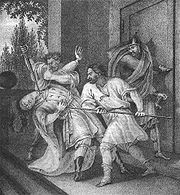 |
Yaropolk I Yaropolk I of Kiev Yaropolk I Svyatoslavich was a young and rather enigmatic ruler of Kiev between 972 and 980. His royal title is traditionally translated as "Prince".... (Jaropolk), supposedly was baptised into Catholicism, and then was murdered by two Varangians |
958 (960?)-980 | 972 | 980 |
Christian rulers of the Kievan Rus'
| Portrait | Name | Born-Died | Ruled From | Ruled Until |
|---|---|---|---|---|
 |
Vladimir I the Great (Valdamarr), son of Sviatoslav I and Malusha Malusha Malusha/Malfrida historically is known as a housekeeper for Olga of Kiev and a concubine of Sviatoslav I of Kiev. According to Slavonic chronicles, she was the mother of Vladimir the Great and sister of Dobrynya... , his early rule is characterized by a staunch pagan reaction but in 988 he was baptized into Orthodoxy and successfully converted Kievan Rus' Kievan Rus' Kievan Rus was a medieval polity in Eastern Europe, from the late 9th to the mid 13th century, when it disintegrated under the pressure of the Mongol invasion of 1237–1240.... to Christianity |
958-1015 | 980 | 1015 |
 |
Sviatopolk I the Accursed Sviatopolk I of Kiev Sviatopolk I Vladimirovich was the Kniaz' of Turov and Velikii Kniaz of Kiev whose paternity and guilt in the murder of brothers are disputed.-Early life:Sviatopolk's mother was a Greek nun captured by Sviatoslav I in Bulgaria and married to his lawful heir... (Sventopluk), son of Yaropolk I and a Greek nun |
980-1019 | 1015 | 1019 |
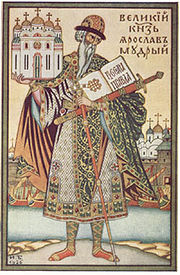 |
Yaroslav I the Wise (Jarizleifr), son of Vladimir the Great (Valdamarr) and Rogneda of Polotsk Rogneda of Polotsk Rogneda of Polotsk is the Slavic name for Ragnhild, whose father Ragnvald came from overseas and established himself at Polatsk in the mid-10th century.... (Ragnhild), Prince of Rostov Rostov Rostov is a town in Yaroslavl Oblast, Russia, one of the oldest in the country and a tourist center of the Golden Ring. It is located on the shores of Lake Nero, northeast of Moscow. Population:... , Prince of Novgorod, and Grand Prince of Kiev Kiev Kiev or Kyiv is the capital and the largest city of Ukraine, located in the north central part of the country on the Dnieper River. The population as of the 2001 census was 2,611,300. However, higher numbers have been cited in the press.... ; during his reign Kievan Rus' Kievan Rus' Kievan Rus was a medieval polity in Eastern Europe, from the late 9th to the mid 13th century, when it disintegrated under the pressure of the Mongol invasion of 1237–1240.... reached the pinnacle of its power |
978-1054 | 1019 | 1054 |
| |Iziaslav I of Kiev Iziaslav I of Kiev Iziaslav Yaroslavich , Kniaz' , Veliki Kniaz of Kiev , King of Rus'... , son of Yaroslav and Ingegerd Olofsdotter of Sweden Ingegerd Olofsdotter of Sweden Princess Ingegerd Olofsdotter of Sweden also known as Irene, Anna and St. Anna , was a Swedish princess and a Grand Princess of Kiev. She was the daughter of Swedish King Olof Skötkonung and Estrid of the Obotrites and the consort of Yaroslav I the Wise of Kiev.Ingegerd or St. Anna is often... , first time |
1024–1078 | 1054 | 1068 | |
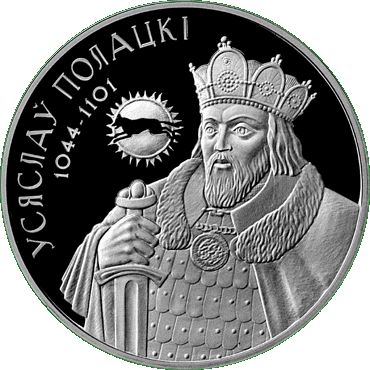 |
Vseslav I of Polotsk Vseslav of Polotsk Vseslav of Polotsk , also known as Vseslav the Sorcerer or Vseslav the Seer, was the most famous ruler of Polotsk and was briefly Grand Prince of Kiev in 1068–1069. Together with Rostislav Vladimirovich and voivode Vyshata made up a coalition against the Yaroslaviches triumvirate... , son of Bryachislav of Polotsk Bryachislav of Polotsk Bryachislav Izyaslavich was the prince of Polatsk between 1001 and 1044. His name, possibly, may have been of something in approximation to Vratislav or Wroclaw. He was son of Izyaslav Vladimirovich. During his reign Polotsk was at war with Kiev and Novgorod... and unknown mother, a brief ruler during Iziaslav's official reign |
1039–1101 | 1068 | 1069 |
| |Iziaslav I of Kiev Iziaslav I of Kiev Iziaslav Yaroslavich , Kniaz' , Veliki Kniaz of Kiev , King of Rus'... , second time |
1024–1078 | 1069 | 1073 | |
| Sviatoslav II of Kiev Sviatoslav II of Kiev Sviatoslav Iaroslavich was the Prince of Chernihiv from 1054 to 1073 and Grand Prince of Kiev from 1073 until his death... (on picture, first from right), son of Yaroslav and Ingegerd Olofsdotter of Sweden Ingegerd Olofsdotter of Sweden Princess Ingegerd Olofsdotter of Sweden also known as Irene, Anna and St. Anna , was a Swedish princess and a Grand Princess of Kiev. She was the daughter of Swedish King Olof Skötkonung and Estrid of the Obotrites and the consort of Yaroslav I the Wise of Kiev.Ingegerd or St. Anna is often... |
1027–1076 | 1073 | 1076 | |
| |Iziaslav I of Kiev Iziaslav I of Kiev Iziaslav Yaroslavich , Kniaz' , Veliki Kniaz of Kiev , King of Rus'... , third time, first King of Rus' (Pope Gregory VII Pope Gregory VII Pope St. Gregory VII , born Hildebrand of Sovana , was Pope from April 22, 1073, until his death. One of the great reforming popes, he is perhaps best known for the part he played in the Investiture Controversy, his dispute with Henry IV, Holy Roman Emperor affirming the primacy of the papal... sent him a crown from Rome in 1075) |
1024–1078 | 1076 | 1078 | |
| |Vsevolod I of Kiev Vsevolod I of Kiev Vsevolod I Yaroslavich , ruled as Grand Prince of Kiev from 1078 until his death.-Early life:... , son of Yaroslav and Ingegerd Olofsdotter of Sweden Ingegerd Olofsdotter of Sweden Princess Ingegerd Olofsdotter of Sweden also known as Irene, Anna and St. Anna , was a Swedish princess and a Grand Princess of Kiev. She was the daughter of Swedish King Olof Skötkonung and Estrid of the Obotrites and the consort of Yaroslav I the Wise of Kiev.Ingegerd or St. Anna is often... |
1030–1093 | 1078 | 1093 | |
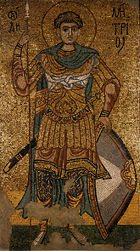 |
Sviatopolk II of Kiev Sviatopolk II of Kiev Sviatopolk II Iziaslavich was supreme ruler of the Kievan Rus for 20 years, from 1093 to 1113. He was not a popular prince, and his reign was marked by incessant rivalry with his cousin Vladimir Monomakh... , son of Iziaslav I and Gertrude of Poland Gertrude of Poland Gertrude , princess of Poland, was the daughter of King Mieszko II of Poland and Richeza of Lotharingia.In 1043, she was married to Iziaslav I of Kiev. She had three sons, Yaropolk Iziaslavich, Mstislav and Sviatopolk II, by her husband.Her daughter Eupraxia later married her cousin's son Mieszko... |
1050–1113 | 1093 | 1113 |
 |
Vladimir II Monomakh Vladimir II Monomakh Vladimir II Monomakh |Basileios]]) was a Velikiy Kniaz of Kievan Rus'.- Family :He was the son of Vsevolod I and Anastasia of Byzantium Vladimir II Monomakh |Basileios]]) (1053 – May 19, 1125) was a Velikiy Kniaz (Grand Prince) of Kievan Rus'.- Family :He was the son of Vsevolod I (married in... , son of Vsevolod I and Anastasia of Byzantium, he is considered to be the last ruler of the united Kievan Rus' Kievan Rus' Kievan Rus was a medieval polity in Eastern Europe, from the late 9th to the mid 13th century, when it disintegrated under the pressure of the Mongol invasion of 1237–1240.... |
1053–1125 | 1113 | 1125 |
| Mstislav I the Great Mstislav I of Kiev Mstislav I Vladimirovich the Great was the Grand Prince of Kiev , the eldest son of Vladimir II Monomakh by Gytha of Wessex... , known as Harald Harald Harald or Harold is the name of several kings and lesser rulers:Kings of Denmark*Harald I of Denmark , also known as Harald Bluetooth.*Harald II of Denmark*Harald III of DenmarkKings of England... in the Norse Saga Norse saga The sagas are stories about ancient Scandinavian and Germanic history, about early Viking voyages, the battles that took place during the voyages, about migration to Iceland and of feuds between Icelandic families... s, son of Vladimir II and Gytha of Wessex Gytha of Wessex Gytha of Wessex was one of several daughters of Edith Swanneck by Harold II, the last Anglo-Saxon king of England.According to Saxo Grammaticus, two of Harold's sons and a daughter escaped to the court of their uncle, king Sweyn Estridsson of Denmark. They were treated by Sweyn with hospitality,... , after his reign Kievan Rus' Kievan Rus' Kievan Rus was a medieval polity in Eastern Europe, from the late 9th to the mid 13th century, when it disintegrated under the pressure of the Mongol invasion of 1237–1240.... fell into recession starting a rapid decline |
1076–1132 | 1125 | 1132 | |
Decline of Kievan Rus'
After the Council of LiubechCouncil of Liubech
The Council of Liubech was the first known federal council of the Kievan Rus'. It was held in 1097 between the constantly rivaling regional princes...
in 1097 Kievan Rus'
Kievan Rus'
Kievan Rus was a medieval polity in Eastern Europe, from the late 9th to the mid 13th century, when it disintegrated under the pressure of the Mongol invasion of 1237–1240....
entered a feudal period and was divided into principalities ruled by the Rurikid family princes who were in a constant power struggle with each other. Major principalities were: Galicia-Volhynia, Kiev, Chernigiv, and Pereyaslavl
Principality of Pereyaslavl
The Principality of Pereslavl was a regional principality of Kievan Rus from the end of 9th to 1302 based on the city of Pereyaslavl on the Trubezh river. It was usually administrated by younger sons of the Grand Prince of Kiev...
. In the period of 1240–1362, the three latter ones were forced to accept the Golden Horde
Golden Horde
The Golden Horde was a Mongol and later Turkicized khanate that formed the north-western sector of the Mongol Empire...
overlordship.

Grand Prince of Kiev
- Yaropolk IIYaropolk II of KievYaropolk II Vladimirovich , Prince of Pereyaslav , Velikiy Kniaz of Kiev , son of Vladimir II Monomakh and Gytha of Wessex. He fought in several campaigns against the Polovtsy , once in 1103 and again in 1116.After the death of his brother in 1132, Msitslav I the Great, Yaropolk received the...
(1132–1139) - Vyacheslav I (1139) (first time)
- Vsevolod IIVsevolod II of KievVsevolod II Olgovich was the Prince of Chernigov and Grand Prince of Kiev , son of Oleg Svyatoslavich, Prince of Chernigov....
(1139–1146) - Igor IIIgor II of KievIgor II Olgovich , Prince of Chernigov and Grand Prince of Kiev . Son of Oleg Svyatoslavich of Chernigov . Saint - feast day: 5 June....
(1146) - Iziaslav IIIziaslav II of KievIziaslav II Mstislavich , Prince of Pereyaslav , Prince of Turov , Prince of Rostov , Prince of Vladimir and Volyn , Pereyaslavl , Velikiy Kniaz of Kiev , was the oldest son of Mstislav Vladimirovich, Kniaz' , and...
(1146–1149) (first time) - Yuri I Dolgorukiy (1149–1151) (first time)
- Vyacheslav I (1151–1155) (second time)
- Iziaslav IIIziaslav II of KievIziaslav II Mstislavich , Prince of Pereyaslav , Prince of Turov , Prince of Rostov , Prince of Vladimir and Volyn , Pereyaslavl , Velikiy Kniaz of Kiev , was the oldest son of Mstislav Vladimirovich, Kniaz' , and...
(1151–1154) (second time) - Rostislav IRostislav I of KievRostislav Mstislavich , Kniaz' of Smolensk , Novgorod and Velikiy Kniaz of Kiev . He was the son of Mstislav I of Kiev and Christina Ingesdotter of Sweden....
(1154) (first time) - Iziaslav IIIIziaslav III of KievIzyaslav III Davidovich , Prince of Chernigov and Grand Prince of Kiev . He was the son of Davyd Sviatoslavich of Chernigov....
(1154–1155) (first time) - Yuri I Dolgorukiy (1155–1157) (second time)
- Iziaslav IIIIziaslav III of KievIzyaslav III Davidovich , Prince of Chernigov and Grand Prince of Kiev . He was the son of Davyd Sviatoslavich of Chernigov....
(1157–1158) (second time) - Rostislav IRostislav I of KievRostislav Mstislavich , Kniaz' of Smolensk , Novgorod and Velikiy Kniaz of Kiev . He was the son of Mstislav I of Kiev and Christina Ingesdotter of Sweden....
(1159–1167) (second time) - Iziaslav IIIIziaslav III of KievIzyaslav III Davidovich , Prince of Chernigov and Grand Prince of Kiev . He was the son of Davyd Sviatoslavich of Chernigov....
(1162) (third time) - Mstislav IIMstislav II of KievMstislav II Izyaslavich , Kniaz' of Pereyaslav, Volodymyr-Volynsky and Velikiy Kniaz of Kiev . Son of Izyaslav Mstislavich, Velikiy Kniaz' of Kiev....
(1167–1169) (first time) - Gleb I of Kursk (1169) (first time)
- Mstislav IIMstislav II of KievMstislav II Izyaslavich , Kniaz' of Pereyaslav, Volodymyr-Volynsky and Velikiy Kniaz of Kiev . Son of Izyaslav Mstislavich, Velikiy Kniaz' of Kiev....
(1170) (second time) - Gleb I of Kursk (1170–1171) (second time)
- Vladimir III (1171)
- Mikhail IMikhail of VladimirMikhalko Yuryevich , Prince of Torchesk , Vladimir and Suzdal and Grand Prince of Kiev ....
(1171) - Roman I (1171–1173) (first time)
- Vsevolod III the Big Nest (1173)
- Rurik IIRurik RostislavichRuryk Rostislavich , Prince of Novgorod , Belgorod Kievsky, presently Bilohorodka , Grand Prince of Kiev , Prince of Chernigov...
(1173) (first time) - Sviatoslav IIISviatoslav III of KievSviatoslav III Vsevolodovich , Prince of Turov , Vladimir and Volyn , Pinsk , Novgorod-Seversky , Chernigov , Grand Prince of Kiev...
(1174) (first time) - Yaroslav IIYaroslav II of KievYaroslav II Iziaslavich , Prince of Turov , Novgorod , Lutsk and Grand Prince of Kiev . He was the son of Iziaslav II of Kiev and the brother of Mstislav II of Kiev....
(1174–1175) (first time) - Roman I (1175–1177) (second time)
- Sviatoslav IIISviatoslav III of KievSviatoslav III Vsevolodovich , Prince of Turov , Vladimir and Volyn , Pinsk , Novgorod-Seversky , Chernigov , Grand Prince of Kiev...
(1177–1180) (second time) - Yaroslav IIYaroslav II of KievYaroslav II Iziaslavich , Prince of Turov , Novgorod , Lutsk and Grand Prince of Kiev . He was the son of Iziaslav II of Kiev and the brother of Mstislav II of Kiev....
(1180) (second time) - Rurik IIRurik RostislavichRuryk Rostislavich , Prince of Novgorod , Belgorod Kievsky, presently Bilohorodka , Grand Prince of Kiev , Prince of Chernigov...
(1180–1182) (second time) - Sviatoslav IIISviatoslav III of KievSviatoslav III Vsevolodovich , Prince of Turov , Vladimir and Volyn , Pinsk , Novgorod-Seversky , Chernigov , Grand Prince of Kiev...
(1182–1194) (third time) - Rurik IIRurik RostislavichRuryk Rostislavich , Prince of Novgorod , Belgorod Kievsky, presently Bilohorodka , Grand Prince of Kiev , Prince of Chernigov...
(1194–1202) (third time) - Ingvar I of Lutsk (1202)
- Rurik IIRurik RostislavichRuryk Rostislavich , Prince of Novgorod , Belgorod Kievsky, presently Bilohorodka , Grand Prince of Kiev , Prince of Chernigov...
(1203–1205) (fourth time) - Roman II the GreatRoman the GreatRoman Mstislavich , also Roman Mstyslavych or Roman the Great, was a Rus’ prince, Grand Prince of Kiev ....
(1203–1205) - Rostislav IIRostislav II of KievRostyslav Rurykovych , Prince of Torchesk , Grand Prince of Kiev , Prince of Vyshhorod , Prince of Halych . Son of Rurik Rostislavich.-References:...
(1204–1206) - Rurik IIRurik RostislavichRuryk Rostislavich , Prince of Novgorod , Belgorod Kievsky, presently Bilohorodka , Grand Prince of Kiev , Prince of Chernigov...
(1206) (fifth time) - Vsevolod IVVsevolod IV of KievVsevolod IV Svyatoslavich the Red was a Rus' prince . His baptismal name was Daniil...
(1206–1207) (first time) - Rurik IIRurik RostislavichRuryk Rostislavich , Prince of Novgorod , Belgorod Kievsky, presently Bilohorodka , Grand Prince of Kiev , Prince of Chernigov...
(1207–10) (sixth time) - Vsevolod IVVsevolod IV of KievVsevolod IV Svyatoslavich the Red was a Rus' prince . His baptismal name was Daniil...
(1210–1214) (second time) - Igor I of Lutsk (1214)
- Mstislav IIIMstislav III of KievMstislav Romanovich the Old , Prince of Pskov , Smolensk , Belgorod , Halych and Grand Prince of Kiev...
(1214–1223) - Vladimir IV (1223–1235)
- Iziaslav IVIziaslav IV VladimirovichIziaslav IV Vladimirovich , was the Prince of Terebovlya and Novgorod-Seversky and Grand Prince of Kiev . He was the son of Vladimir Igorevich....
(1235–1236) - Yaroslav II of VladimirYaroslav II of VladimirYaroslav II , Christian name Theodor was the Grand Prince of Vladimir who helped to restore his country and capital after the Mongol invasion of Russia.-Prince of Pereyaslav:...
(1236–1238) (first time) - Michael IIMichael of ChernigovSaint Michael of Chernigov or Mikhail Vsevolodovich was a Rus' prince...
(1238–1239) (first time) - Rostislav III (1239)
- Daniel I of Galicia (1239–1240)
- Michael IIMichael of ChernigovSaint Michael of Chernigov or Mikhail Vsevolodovich was a Rus' prince...
(1241–1243) (second time) - Yaroslav II of VladimirYaroslav II of VladimirYaroslav II , Christian name Theodor was the Grand Prince of Vladimir who helped to restore his country and capital after the Mongol invasion of Russia.-Prince of Pereyaslav:...
(1143–1246) (second time) - Alexander I NevskyAlexander NevskyAlexander Nevsky was the Prince of Novgorod and Grand Prince of Vladimir during some of the most trying times in the city's history. Commonly regarded as the key figure of medieval Rus, Alexander was the grandson of Vsevolod the Big Nest and rose to legendary status on account of his military...
(1249–1263) - Yaroslav III (1263–1271)
- Lev I of Galicia (1271-1301)
- Volodymyr-Ivan Ivanovich (ca.1300-ca.1310)
- Ostap Ivanovich (?-?)
- Stanislav Ivanovich (?-ca.1324)
- Olgimont-Mykhailo (Algimantas Alšėniškis) (1324–1331)
- Fiodor of KievFiodor of KievFiodor of Kiev , was a prince of Kiev. He was the son of Butvydas, and a younger brother of Gediminas, Grand Duke of Lithuania. Only a couple of short notes survive regarding Fiodor's life....
(Teodoras Butvydaitis) (1331–1362)
Princes of Pereyaslavl
- Vsevolod I of KievVsevolod I of KievVsevolod I Yaroslavich , ruled as Grand Prince of Kiev from 1078 until his death.-Early life:...
, 1054–1076 - Rostislav Vsevolodich, d. 1093
- Vladimir II MonomakhVladimir II MonomakhVladimir II Monomakh |Basileios]]) was a Velikiy Kniaz of Kievan Rus'.- Family :He was the son of Vsevolod I and Anastasia of Byzantium Vladimir II Monomakh |Basileios]]) (1053 – May 19, 1125) was a Velikiy Kniaz (Grand Prince) of Kievan Rus'.- Family :He was the son of Vsevolod I (married in...
, 1076–1078 (first time) - Rostislav Vsevolodich, 1078–1093
- Vladimir II Monomakh, 1094–1113 (second time)
- Sviatoslav Vladimirovich, d. 1114
- Yaropolk II of KievYaropolk II of KievYaropolk II Vladimirovich , Prince of Pereyaslav , Velikiy Kniaz of Kiev , son of Vladimir II Monomakh and Gytha of Wessex. He fought in several campaigns against the Polovtsy , once in 1103 and again in 1116.After the death of his brother in 1132, Msitslav I the Great, Yaropolk received the...
, 1114–1132 - Vsevolod Mstislavich, 1132 (first time)
- Iziaslav Mstislavich, 1132 (first time)
- Vyacheslav Vladimirovich, 1132–1134 (first time)
- Vsevolod Mstislavich, 1134 (second time)
- Iziaslav Mstislavich, 1134 (second time)
- Andrey Vladimirovich, 1135–1141
- Vyacheslav Vladimirovich, 1142 (second time)
- Iziaslav II of KievIziaslav II of KievIziaslav II Mstislavich , Prince of Pereyaslav , Prince of Turov , Prince of Rostov , Prince of Vladimir and Volyn , Pereyaslavl , Velikiy Kniaz of Kiev , was the oldest son of Mstislav Vladimirovich, Kniaz' , and...
, 1143–1145 - Mstislav Izyaslavich, 1146–1149 (first time)
- Rostislav Yurevich, 1149–1151
- Mstislav Izyaslavich, 1151–1155 (second time)
- Gleb of KievGleb of KievGleb Yuryevich , Prince of Kursk , Kanev , Pereyaslavl and Grand Prince of Kiev . Son of Yuri Dolgoruky....
, 1155–1169 - Vladimir Glebovich, 1169–1187
- Yaroslav Mstislavich, ?-?
- Vsevolod the Big Nest, ?-1206
- Vsevolod Chermnyi Svyatoslavich, 1206
- Rurik Rostislavich, 1206
- Vladimir III RurikovichVladimir III RurikovichVladimir IV Rurikovich , Prince of Pereyaslavl , Smolensk and Grand Prince of Kiev . Son of Rurik Rostislavich....
, 1206–1213
Princes of Chernihiv
- Sviatoslav II of KievSviatoslav II of KievSviatoslav Iaroslavich was the Prince of Chernihiv from 1054 to 1073 and Grand Prince of Kiev from 1073 until his death...
, 1054–1073 - Vsevolod I of KievVsevolod I of KievVsevolod I Yaroslavich , ruled as Grand Prince of Kiev from 1078 until his death.-Early life:...
, 1073–1076 (first time) - Vladimir Monomakh, 1076–1077
- Boris VyacheslavichBoris VyacheslavichBoris Vyacheslavich was a prince of Tmutarakan, son of Vyacheslav Yaroslavich . Boris was izgoi from the Rurikid dynasty of Kievan Rus’....
, 1077 - Vsevolod Yaroslavich, 1077–1078 (second time)
- Oleg I of ChernigovOleg I of ChernigovOleg Svyatoslavich of Chernigiv , sometimes also styled as of Tmutarakan, was a Rurikid prince whose equivocal adventures ignited political unrest in Kievan Rus at the turn of the 11th and 12th centuries....
, 1078 - Vladimir Monomakh (second time), 1078–1094
- Oleg Sviatoslavich, 1094–1097
- David Sviatolavich, 1097–1123
- Yaroslav Sviatoslavich, 1123–1126
- Vsevolod II of KievVsevolod II of KievVsevolod II Olgovich was the Prince of Chernigov and Grand Prince of Kiev , son of Oleg Svyatoslavich, Prince of Chernigov....
, 1126–1139 - Vladimir Davidovich, 1139–1151
- Iziaslav Davidovich, 1151–1154
- Sviatoslav Olgovich, 1157–1164
- Oleg Sviatoslavich, 1164
- Sviatoslav Vsevolodich, 1164–1177
- Yaroslav II VsevolodovichYaroslav II VsevolodovichYaroslav II Vsevolodovich was a Rus’ prince . He was prince of Ropesk , of Starodub , and of Chernigov...
(1176–1198) - Igor Svyatoslavich the BraveIgor SvyatoslavichIgor Svyatoslavich the Brave was a Rus’ prince...
(1198-1201/1202) - Oleg III SvyatoslavichOleg III Svyatoslavich (Prince of Chernigov)Oleg III Svyatoslavich was a Rus' prince . His baptismal name was Feodosy. He was prince of Vshchizh , of Novgorod-Seversk , and of Chernigov .-His life:...
(1201/1202-1204) - Vsevolod III SvyatoslavichVsevolod IV of KievVsevolod IV Svyatoslavich the Red was a Rus' prince . His baptismal name was Daniil...
(1204-1206/1208) - Gleb I SvyatoslavichGleb Svyatoslavich (Prince of Chernigov)Gleb Svyatoslavich was a Rus' prince . His baptismal name was Pakhomy. He was prince of Kaniv , of Belgorod , and of Chernigov . He helped to pay for the Church of St...
(1206/1208-1215/1220) - Mstislav II Svyatoslavich (1215/1220-1223)
- Mikhail I VsevolodovichMichael of ChernigovSaint Michael of Chernigov or Mikhail Vsevolodovich was a Rus' prince...
(1223–1235) (first time) - Mstislav III GlebovichMstislav III Glebovich (Prince of Chernigov)Mstislav III Glebovich was a Rus' prince . He was probably prince of Rylsk and of Chernigov...
(1235-1239/1241) - Rostislav I Mikhailovich (1241–1242)
- Mikhail I Vsevolodovich (1242–1246) (second time)
- Roman I Mikhailovich the OldRoman Mikhailovich (Prince of Chernigov)Roman Mikhailovich the Old was a Rus' prince . He was prince of Chernigov , and of Bryansk .-His life:...
(1246/1247-after 1288) - Oleg Romanovich, 13th century
- Mikhail, late 13th-early 14th century
- Mikhail Aleksandrovich, 14th cent.
- Roman Mikhailovich (the younger), d. 1370
- Kaributas Algirdaitis (Dymitr Korybut, or Koribut), c. 1372–1393
- Roman Mikhailovich (the younger), restored, 1393–1401
- ŠvitrigailaŠvitrigailaŠvitrigaila Švitrigaila Švitrigaila (ca 1370 – 10 February 1452; was the Grand Duke of Lithuania from 1430 to 1432. He spent most of his life in largely unsuccessful dynastic struggles against his cousins Vytautas and Sigismund Kęstutaitis.-Struggle against Vytautas:...
, 1419–1430
Kings and Princes of Galicia-Volhynia (1199–1349)
Galicia-Volhynia was a RuthenianRuthenian
Ruthenian may refer to:*Ruthenia, a name applied to various parts of Eastern Europe*Ruthenians, a historic ethnic group*Ruthenian Catholic Church, the sui iuris particular church united to the Bishop of Rome and the Roman Catholic Church...
(Ukrainian) state in Galicia and Volhynia
Volhynia
Volhynia, Volynia, or Volyn is a historic region in western Ukraine located between the rivers Prypiat and Southern Bug River, to the north of Galicia and Podolia; the region is named for the former city of Volyn or Velyn, said to have been located on the Southern Bug River, whose name may come...
. Depending on the title of the ruler it was called either principality or kingdom. The first king, Coloman of Galicia-Lodomeria, was crowned in 1215, although the first nominal king of Galicia was Andrew II of Hungary
Andrew II of Hungary
Andrew II the Jerosolimitan was King of Hungary and Croatia . He was the younger son of King Béla III of Hungary, who invested him with the government of the Principality of Halych...
, the son of Béla III of Hungary
Béla III of Hungary
Béla III was King of Hungary and Croatia . He was educated in the court of the Byzantine Emperor Manuel I who was planning to ensure his succession in the Byzantine Empire till the birth of his own son...
, who reigned from 1188 to 1190.
| Portrait | Name | Born-Died | Ruled From | Ruled Until | |
|---|---|---|---|---|---|
 |
Roman II the Great Roman the Great Roman Mstislavich , also Roman Mstyslavych or Roman the Great, was a Rus’ prince, Grand Prince of Kiev .... , Prince of Novgorod (1168–1170), Prince of Volhynia Volhynia Volhynia, Volynia, or Volyn is a historic region in western Ukraine located between the rivers Prypiat and Southern Bug River, to the north of Galicia and Podolia; the region is named for the former city of Volyn or Velyn, said to have been located on the Southern Bug River, whose name may come... (1170–1188, 1189–1205), Prince of Halych Halych Halych is a historic city on the Dniester River in western Ukraine. The town gave its name to the historic province and kingdom of Kingdom of Galicia–Volhynia, of which it was the capital until the early 14th century, when the seat of the local princes was moved to Lviv... (1188, 1199–1205), and Grand Prince of Kiev (1204–1205) |
fl.1160–1205 | 1199 | 1205 | |
| |Coloman of Galicia-Lodomeria, Hungarian prince Kálmán, Prince of Halych Halych Halych is a historic city on the Dniester River in western Ukraine. The town gave its name to the historic province and kingdom of Kingdom of Galicia–Volhynia, of which it was the capital until the early 14th century, when the seat of the local princes was moved to Lviv... (1214–15), became the first anointed and crowned and King of Galicia-Volhynia (rex Galiciae et Lodomeriae) in 1215 |
1208–1241 | 1214 | 1219 | ||
| Daniel I of Galicia, held many titles since early childhood culminating with the crowning by a papal legate, archbishop Opizo, in Dorohychyn Drohiczyn Drohiczyn is a small historic town in Siemiatycze County, Podlaskie Voivodeship, Poland. The town with population 2,110 is situated on a bank of the Bug River.- History :... in 1253, King of Rus' King of Rus' King of Rus, later Ruthenian king of Galicia-Volhynia was a title of monarch of Kievan Rus' and Rus' kingdom, which granted the Pope.- Kings of Rus' kingdom :... , Grand Prince of Kiev |
1201–1264 | 1205 | 1264 | , | |
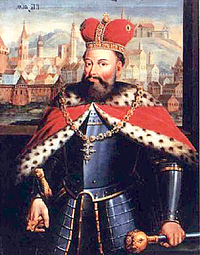 |
Lev I, King of Rus', Prince of Belz Belz Belz , a small city in the Lviv Oblast of Western Ukraine, near the border with Poland, is located between the Solokiya river and the Rzeczyca stream.... (1245–1264), Prince of Peremyshl Peremyshl Peremyshl may refer to:*Peremyshl, Russia, a village in Kaluga Oblast, Russia*Peremyshl, a Cyrillic alphabet transliteration of the city of Przemyśl... and Halych Halych Halych is a historic city on the Dniester River in western Ukraine. The town gave its name to the historic province and kingdom of Kingdom of Galicia–Volhynia, of which it was the capital until the early 14th century, when the seat of the local princes was moved to Lviv... (1264–1269) who moved the capital of Galicia from Kholm to Lviv in 1272, Grand Prince of Kiev (1271-1301) |
1228–1301 | 1293 | 1301 | |
| |Yuri I, King of Rus', Prince of Belz Belz Belz , a small city in the Lviv Oblast of Western Ukraine, near the border with Poland, is located between the Solokiya river and the Rzeczyca stream.... (1264–1301) |
fl.1252–1308 | 1301 | 1308, | ||
| |Andrew II Andrew of Galicia Andriy II Yuriyevych or Andrew of Galicia was the last Rus' king of Galicia-Volhynia in 1308–1323 . He was the son of Yuriy I whom he succeeded on the royal throne of Galicia. His mother was Euphemia of Kuyavia. After the death of his father, he ruled the kingdom together with his... and Lev II Lev II of Galicia Lev Yurevich or Lev II of Galicia was the last Rurikid king of Galicia-Volhynia in 1308–1323 . He was the son of Yuri I of Galicia whom he succeeded on the royal throne of Galicia. After the death of his father, he ruled the kingdom together with his brother Andrey. His mother was Euphemia... , Kings of Rus', princes, joint rule, the last members of the Rurikid dynasty to rule Ukraine |
?–1323 | 1308 | 1323 | ||
 |
Yuri II-Boleslaw, King of Rus', prince, a member of the Piast dynasty Piast dynasty The Piast dynasty was the first historical ruling dynasty of Poland. It began with the semi-legendary Piast Kołodziej . The first historical ruler was Duke Mieszko I . The Piasts' royal rule in Poland ended in 1370 with the death of king Casimir the Great... (Polish noble family) |
1308–1340 | 1323 | 1340 | |
 |
Liubartas, prince, a member of the Gediminid dynasty Gediminids The Gediminids were a dynasty of monarchs of Grand Duchy of Lithuania that reigned from the 14th to the 16th century. One branch of this dynasty, known as the Jagiellons, reigned also in Kingdom of Poland, Kingdom of Hungary and Kingdom of Bohemia... , the last Ruthenian Ruthenians The name Ruthenian |Rus']]) is a culturally loaded term and has different meanings according to the context in which it is used. Initially, it was the ethnonym used for the East Slavic peoples who lived in Rus'. Later it was used predominantly for Ukrainians... -Lithuanian ruler of Galicia-Volhynia, Prince of Volhynia Volhynia Volhynia, Volynia, or Volyn is a historic region in western Ukraine located between the rivers Prypiat and Southern Bug River, to the north of Galicia and Podolia; the region is named for the former city of Volyn or Velyn, said to have been located on the Southern Bug River, whose name may come... (1323–1384) |
ca.1300–1384 | 1340 | 1349 | |
In 1349, Liubartas lost all territories, except for eastern Volhynia, to Casimir III of Poland
Casimir III of Poland
Casimir III the Great , last King of Poland from the Piast dynasty , was the son of King Władysław I the Elbow-high and Hedwig of Kalisz.-Biography:...
. In 1366, a Polish-Lithuanian treaty was signed: eastern Volhynia with Lutsk retained under Liubartas' rule (the Grand Duchy of Lithuania
Grand Duchy of Lithuania
The Grand Duchy of Lithuania was a European state from the 12th /13th century until 1569 and then as a constituent part of Polish-Lithuanian Commonwealth until 1791 when Constitution of May 3, 1791 abolished it in favor of unitary state. It was founded by the Lithuanians, one of the polytheistic...
), while Galicia, western Volhynia, and western Podolia were annexed by the Crown of the Kingdom of Poland.
In the Grand Duchy of Lithuania (1362–1569) and Kingdom of Poland (1569–1667/1793)
Princes of KievIn early 1320s, a Lithuanian army led by Gediminas defeated a Slavic army led by Stanislav of Kiev at the Battle on the Irpen' River
Battle on the Irpen' River
The Battle on the Irpin River occurred in early 1320s between the armies of Gediminas, the Grand Duke of Lithuania, and Prince Stanislav of Kiev, allied with Oleg of Pereyaslavl' and Roman of Bryansk. On the small Irpin River about south west of Kiev, Gediminas resoundingly defeated Stanislav and...
, and conquered the city. The Tatars, who also claimed Kiev, retaliated in 1324–1325, so while Kiev was ruled by a Lithuanian prince, it had to pay a tribute to the Golden Horde
Golden Horde
The Golden Horde was a Mongol and later Turkicized khanate that formed the north-western sector of the Mongol Empire...
. Finally, as a result of the Battle of Blue Waters
Battle of Blue Waters
The Battle of Blue Waters was a medieval battle fought at some time between 24 September and 25 December 1362 near the Syni Vody of the Southern Bug between the armies of the Grand Duchy of Lithuania and the Golden Horde....
in 1362, Kiev and surrounding areas were incorporated into the Grand Duchy of Lithuania by Algirdas
Algirdas
Algirdas was a monarch of medieval Lithuania. Algirdas ruled the Grand Duchy of Lithuania from 1345 to 1377, which chiefly meant monarch of Lithuanians and Ruthenians...
, Grand Duke of Lithuania.
- Algimantas Alšėniškis (Olgimunt Holszański, Olgimont-Mykhailo Olshansky) (1324–1331)
- Fiodor of KievFiodor of KievFiodor of Kiev , was a prince of Kiev. He was the son of Butvydas, and a younger brother of Gediminas, Grand Duke of Lithuania. Only a couple of short notes survive regarding Fiodor's life....
aka Teodoras Butvydaitis, brother of Gediminas (1331–1362) - Vladimiras Algirdaitis (Volodymyr Olgerdovych) (1362–1394)
- SkirgailaSkirgailaSkirgaila , also known as Ivan; ca. 1353 or 1354 – 11 January 1397 in Kiev; baptized 1383/1384 as Casimir) was a regent of the Grand Duchy of Lithuania for his brother Jogaila from 1386 to 1392. He was son of Algirdas, Grand Duke of Lithuania, and his second wife Uliana of Tver.-Biography:After...
(1395–1397) - Ivan Olshansky (Jonas Alšėniškis) (1397-ca.1402)
- Jurgis Gedgaudas; lt (Jerzy Giedygołd) (1404–1411)
- Andriy Ivanovych Olshansky (ca.1412-ca.1422)
- Mykhailo Ivanovych Olshansky (1422–1432)
- Mykhailo Semenovych Boloban Olshansky (1433–1435)
- ŠvitrigailaŠvitrigailaŠvitrigaila Švitrigaila Švitrigaila (ca 1370 – 10 February 1452; was the Grand Duke of Lithuania from 1430 to 1432. He spent most of his life in largely unsuccessful dynastic struggles against his cousins Vytautas and Sigismund Kęstutaitis.-Struggle against Vytautas:...
(1435-ca.1440), Grand Duke of the Duchy of Rus (1432-ca.1440) - Aleksandras Olelka (Olelko Volodymyrovych) (1443–1454)
- Simonas Olelkaitis (Semen Olelkovych) (1454–1471)
Voivodes of Kiev
When the Polish-Lithuanian Commonwealth
Polish-Lithuanian Commonwealth
The Polish–Lithuanian Commonwealth was a dualistic state of Poland and Lithuania ruled by a common monarch. It was the largest and one of the most populous countries of 16th- and 17th‑century Europe with some and a multi-ethnic population of 11 million at its peak in the early 17th century...
was formed by the Union of Lublin
Union of Lublin
The Union of Lublin replaced the personal union of the Kingdom of Poland and the Grand Duchy of Lithuania with a real union and an elective monarchy, since Sigismund II Augustus, the last of the Jagiellons, remained childless after three marriages. In addition, the autonomy of Royal Prussia was...
in 1569, Kiev
Kiev
Kiev or Kyiv is the capital and the largest city of Ukraine, located in the north central part of the country on the Dnieper River. The population as of the 2001 census was 2,611,300. However, higher numbers have been cited in the press....
and surrounding areas, Podolia
Podolia
The region of Podolia is an historical region in the west-central and south-west portions of present-day Ukraine, corresponding to Khmelnytskyi Oblast and Vinnytsia Oblast. Northern Transnistria, in Moldova, is also a part of Podolia...
, Volhynia
Volhynia
Volhynia, Volynia, or Volyn is a historic region in western Ukraine located between the rivers Prypiat and Southern Bug River, to the north of Galicia and Podolia; the region is named for the former city of Volyn or Velyn, said to have been located on the Southern Bug River, whose name may come...
, and Podlaskie, as the Kiev Voivodeship, Bratslav Voivodeship, Volhynian Voivodeship, and Podlaskie Voivodeship
Podlaskie Voivodeship (1513–1795)
The Podlaskie Voivodeship was formed in 1513 by Sigismund I the Old as a voivodeship in the Grand Duchy of Lithuania, from a split off part of the Trakai Voivodeship....
, were transferred from Lithuania to Poland.
Crimean khans (1441–1783)
Crimean TatarsCrimean Tatars
Crimean Tatars or Crimeans are a Turkic ethnic group that originally resided in Crimea. They speak the Crimean Tatar language...
were not of the Ukrainian ethnos
Ethnos
Ethnos may refer to:*Ethnic group*Ethnos...
. Their Crimean Khanate
Crimean Khanate
Crimean Khanate, or Khanate of Crimea , was a state ruled by Crimean Tatars from 1441 to 1783. Its native name was . Its khans were the patrilineal descendants of Toqa Temür, the thirteenth son of Jochi and grandson of Genghis Khan...
ruled a large part of modern Ukraine
History of Ukraine
The territory of Ukraine was a key center of East Slavic culture in the Middle Ages, before being divided between a variety of powers. However, the history of Ukraine dates back many thousands of years. The territory has been settled continuously since at least 5000 BC, and is also a candidate site...
, with a capital at Bakhchisaray
Bakhchisaray
Bakhchisaray is a town in Central Crimea, centre of the Bakhchisaray raion , best known as the former capital of the Crimean Khanate...
.


- Hacı I GirayHaci I GirayHacı I Giray Angel was the founder and the first ruler of the Crimean Khanate. He is sometimes referred to as Hacı Devlet Giray or Devlet Hacı Giray...
, c.1427 or 1441–1456 (first reign) - HayderHayder of CrimeaHayder was a Crimean Khan in 1456, and a son of Hacı I Giray.In 1456, he rebelled against his father and occupied the throne for a short time until the failure of the rebellion....
, 1456 - Hacı I GirayHaci I GirayHacı I Giray Angel was the founder and the first ruler of the Crimean Khanate. He is sometimes referred to as Hacı Devlet Giray or Devlet Hacı Giray...
, 1456–1466 (second reign) - Nur Devlet, 1466–1467 (first reign)
- Meñli I GirayMeñli I GirayMeñli I Giray , also spelled as Mengli I Giray, was a khan of the Crimean Khanate and the sixth son of the khanate founder Haci I Giray....
, 1467 (first reign) - Nur Devlet, 1467–1469 (second reign)
- Meñli I GirayMeñli I GirayMeñli I Giray , also spelled as Mengli I Giray, was a khan of the Crimean Khanate and the sixth son of the khanate founder Haci I Giray....
, 1469–1475 (second reign) - Nur Devlet, 1475–1476 (third reign)
- Vacant, 1476–1478 (dynasty dismissed from power)
- Meñli I GirayMeñli I GirayMeñli I Giray , also spelled as Mengli I Giray, was a khan of the Crimean Khanate and the sixth son of the khanate founder Haci I Giray....
, 1478–1515 (third reign) - Mehmed I GirayMehmed I GirayMehmed I Giray known as Great — a khan of the Crimean Khanate in 1515 –1523.Son of Meñli I Giray, inherited power after his father's death. In 1520 signed a temporary alliance with king of Poland and Grand Duke of Lithuania, Zygmunt I Stary, against Muscovy. In 1521 he took Kazan, where he...
, 1515–1523 - Ğazı I Giray, 1523–1524
- Saadet I Giray, 1524–1532
- İslâm I Giray, 1532
- Sahib I GiraySahib I GiraySahib I Giray — a khan of the Crimean Khanate in 1532 –1551.Son of Meñli I Giray. In 1521 his brother, then Khan of Crimea, Mehmed I Giray, took Kazan, and gave it to Sahib. Together their army defeated Vasili III of Russia near Moscow....
, 1532–1551 - Devlet I GirayDevlet I GirayDevlet I Giray was a khan of the Crimean Khanate during whose long reign the khanate rose to the pinnacle of its power....
, 1551–1577 - Mehmed II Giray, 1577–1584
- Saadet II Giray, 1584
- İslâm II Giray, 1584–1588
- Ğazı II Giray, 1588–1596 (first reign)
- Fetih I Giray, 1596
- Ğazı II Giray, 1596–1607 (second reign)
- Toqtamış Giray, 1607–1608
- Selâmet I Giray, 1608–1610
- Canibek Giray, 1610–1623 (first reign)
- Mehmed III Giray, 1623–1628 †
- Canibek Giray, 1628–1635 (second reign)
- İnayet Giray, 1635–1637
- Bahadır I Giray, 1637–1641
- Mehmed IV GirayMehmed IV GirayMehmed IV Giray Sufi — a khan of the Crimean Khanate in 1641 –1644 and 1654–1656. Supporter of the Polish-Lithuanian Commonwealth. His nickname Sofu means Sufi in Crimean Tatar. Mehmed IV is a famous poet, he wrote his poems mainly on philosophic and religious topics under penname...
, 1641–1644 (first reign) - İslâm III GirayIslâm III Girayİslâm III Giray — a khan of the Crimean Khanate in 1644–1654.In 1648 allied with Zaporozhian Cossack leader Bohdan Khmelnytsky in his revolt against the Polish-Lithuanian Commonwealth. In 1654 after the Treaty of Pereyaslav, he switched sides and allied with Poland against the Tsardom of...
, 1644–1654 - Mehmed IV GirayMehmed IV GirayMehmed IV Giray Sufi — a khan of the Crimean Khanate in 1641 –1644 and 1654–1656. Supporter of the Polish-Lithuanian Commonwealth. His nickname Sofu means Sufi in Crimean Tatar. Mehmed IV is a famous poet, he wrote his poems mainly on philosophic and religious topics under penname...
, 1654–1666 (second reign) - Adil GirayAdil GirayAdil Giray was khan of the Crimean Khanate from 1666 to 1671. He strongly supported the Polish-Lithuanian Commonwealth, and was one of the candidates in the Polish royal election of 1669. In 1671 Giray was removed as khan by Mehmed IV, the Ottoman sultan, when the sultan decided to wage war with...
, 1666–1671 - Selim I GiraySelim I GiraySelim I Giray was a Crimean khan He reigned four times between 1671 – 1704.-Background:Crimean khans were the direct descendants of Genghis Khan, the Mongol Empreror. After the death of Genghis Khan the empire was partitioned and the part in East Europe and Northwest Asia was named Golden...
, 1671–1678 (first reign) - Murad Giray, 1678–1683
- Hacı II Giray, 1683–1684
- Selim I GiraySelim I GiraySelim I Giray was a Crimean khan He reigned four times between 1671 – 1704.-Background:Crimean khans were the direct descendants of Genghis Khan, the Mongol Empreror. After the death of Genghis Khan the empire was partitioned and the part in East Europe and Northwest Asia was named Golden...
, 1684–1691 (second reign) - Saadet III Giray, 1691
- Safa Giray,1691–1692
- Selim I GiraySelim I GiraySelim I Giray was a Crimean khan He reigned four times between 1671 – 1704.-Background:Crimean khans were the direct descendants of Genghis Khan, the Mongol Empreror. After the death of Genghis Khan the empire was partitioned and the part in East Europe and Northwest Asia was named Golden...
, 1692–1699 (third reign) - Devlet II GirayDevlet II GirayDevlet II Giray was Crimean Khan in 1699-1702 and 1709-1713. He occupied the throne between the board and Qaplan I Giray. The eldest son was Selim II Giray.- First Rule :...
, 1699–1702 (first reign) - Selim I GiraySelim I GiraySelim I Giray was a Crimean khan He reigned four times between 1671 – 1704.-Background:Crimean khans were the direct descendants of Genghis Khan, the Mongol Empreror. After the death of Genghis Khan the empire was partitioned and the part in East Europe and Northwest Asia was named Golden...
, 1702–1704 (fourth reign) - Ğazı III Giray, 1704–1707
- Qaplan I Giray, 1707–1708 (first reign)
- Devlet II GirayDevlet II GirayDevlet II Giray was Crimean Khan in 1699-1702 and 1709-1713. He occupied the throne between the board and Qaplan I Giray. The eldest son was Selim II Giray.- First Rule :...
, 1709–1713 (second reign) - Qaplan I Giray, 1713–1715 (second reign)
- Devlet III Giray, 1716–1717
- Saadet IV Giray, 1717–1724
- Meñli II Giray, 1724–1730 (first reign)
- Qaplan I Giray, 1730–1736 (third reign)
- Fetih II Giray, 1736–1737
- Meñli II Giray, 1737–1740 (second reign)
- Selamet II Giray, 1740–1743
- Selim II Giray, 1743–1748
- Arslan Giray, 1748–1756 (first reign)
- Halim Giray, 1756–1758
- Qırım Giray, 1758–1764 (first reign)
- Selim III Giray, 1765–1767 (first reign)
- Arslan Giray, 1767 (second reign)
- Maqsud Giray, 1767–1768
- Qırım Giray, 1768–1769 (second reign)
- Devlet IV Giray, 1769–1770 (first reign)
- Qaplan II GirayQaplan II GirayQaplan II Giray was a Crimean khan of the late 18th century.- Biography :Qaplan ruled from 1769-1770, a very brief reign. During his time as khan of the Crimean Khanate, he negotiated with the Kingdom of Russia for Crimean independence. Qaplan fought against Russia in the Russo-Turkish War for his...
, 1770 - Selim III Giray, 1770–1771 (second reign)
- Sahib II Giray, 1771–1775 †
- Devlet IV Giray, 1775–1777 (second reign)
- Şahin GiraySahin GirayŞahin Giray was the last Khan of Crimea. He was born in 1745 in Edirne.He studied in Greece and also in Venice.He reputedly spoke the Crimean Tatar language as well as Ottoman Turkish, Italian and Greek....
, 1777–1782 (first reign) - Bahadır II Giray, 1782
- Şahin GiraySahin GirayŞahin Giray was the last Khan of Crimea. He was born in 1745 in Edirne.He studied in Greece and also in Venice.He reputedly spoke the Crimean Tatar language as well as Ottoman Turkish, Italian and Greek....
, 1782–1783 (second reign)
† The reigns of Canibek Giray in 1624 and of Maqsud Giray in 1771–1772 are not listed. Though these khans were formally appointed by Ottoman
Ottoman Empire
The Ottoman EmpireIt was usually referred to as the "Ottoman Empire", the "Turkish Empire", the "Ottoman Caliphate" or more commonly "Turkey" by its contemporaries...
sultans they did not reach the throne and did not rule Crimea
Crimea
Crimea , or the Autonomous Republic of Crimea , is a sub-national unit, an autonomous republic, of Ukraine. It is located on the northern coast of the Black Sea, occupying a peninsula of the same name...
. In the years mentioned, the authority in the Crimean Khanate
Crimean Khanate
Crimean Khanate, or Khanate of Crimea , was a state ruled by Crimean Tatars from 1441 to 1783. Its native name was . Its khans were the patrilineal descendants of Toqa Temür, the thirteenth son of Jochi and grandson of Genghis Khan...
was exercised by Mehmed III Giray and Sahib II Giray correspondingly.
The nominal khans Şahbaz Giray (1787–1789) and Baht Giray (1789–1792) mentioned in some works are not listed in this table as they did not rule the Crimean Khanate annexed by Russian Empire
Russian Empire
The Russian Empire was a state that existed from 1721 until the Russian Revolution of 1917. It was the successor to the Tsardom of Russia and the predecessor of the Soviet Union...
in 1783.
Hetmans of Ukrainian Cossacks (1506–1775)
A HetmanHetman
Hetman was the title of the second-highest military commander in 15th- to 18th-century Poland and the Grand Duchy of Lithuania, which together, from 1569 to 1795, comprised the Polish-Lithuanian Commonwealth, or Rzeczpospolita....
was a military and civil leader, democratically elected by the Cossack
Cossack
Cossacks are a group of predominantly East Slavic people who originally were members of democratic, semi-military communities in what is today Ukraine and Southern Russia inhabiting sparsely populated areas and islands in the lower Dnieper and Don basins and who played an important role in the...
s.
Hetmans and commanders of Ukrainian Cossacks
Several Cossack regiments were operating in UkraineUkraine
Ukraine is a country in Eastern Europe. It has an area of 603,628 km², making it the second largest contiguous country on the European continent, after Russia...
at this time that were largely independent of each other, so some of the Hetmans'
Hetman
Hetman was the title of the second-highest military commander in 15th- to 18th-century Poland and the Grand Duchy of Lithuania, which together, from 1569 to 1795, comprised the Polish-Lithuanian Commonwealth, or Rzeczpospolita....
tenures overlap.
| Portrait | Name | Born-Died | Ruled From | Ruled Until |
|---|---|---|---|---|
| Przecław Lanckoroński, was a member of the Zadora Polish szlachta Szlachta The szlachta was a legally privileged noble class with origins in the Kingdom of Poland. It gained considerable institutional privileges during the 1333-1370 reign of Casimir the Great. In 1413, following a series of tentative personal unions between the Grand Duchy of Lithuania and the Kingdom of... family and starosta Starosta Starost is a title for an official or unofficial position of leadership that has been used in various contexts through most of Slavic history. It can be translated as "elder"... of Khmilnyk Khmilnyk Khmilnyk is a resort town in Vinnytsia Oblast, Ukraine. The population is 27,900 .The town is situated in the upper part of the river Southern Buh, northeast of Vinnytsia. It is one of the oldest towns of Podillia.-Early history:... |
?-1531 | 1506 | 1512 | |
 |
Ataman Ataman Ataman was a commander title of the Ukrainian People's Army, Cossack, and haidamak leaders, who were in essence the Cossacks... Ostap Dashkevych Ostap Dashkevych Eustachy or Ostap Dashkevych was a commander of a Cossack defense force, approved by the Sejm. He held the position of starosta of Cherkasy in the early stages of the development of the cossacks, and is sometimes mistakenly referred to as a hetman... , was a commander of the Cossacks, sometimes referred to as Hetman Hetman Hetman was the title of the second-highest military commander in 15th- to 18th-century Poland and the Grand Duchy of Lithuania, which together, from 1569 to 1795, comprised the Polish-Lithuanian Commonwealth, or Rzeczpospolita.... |
1495–1535 | 1506 | 1535 |
| Dmytro Vyshnevetsky Dmytro Vyshnevetsky Dmytro Ivanovych Vyshnevetsky was a Hetman of the Ukrainian Cossacks. He was also known as Baida in the Ukrainian folk songs.-Biography:... , the first to be officially and casually referred to as Cossack Cossack Cossacks are a group of predominantly East Slavic people who originally were members of democratic, semi-military communities in what is today Ukraine and Southern Russia inhabiting sparsely populated areas and islands in the lower Dnieper and Don basins and who played an important role in the... Hetman Hetman Hetman was the title of the second-highest military commander in 15th- to 18th-century Poland and the Grand Duchy of Lithuania, which together, from 1569 to 1795, comprised the Polish-Lithuanian Commonwealth, or Rzeczpospolita.... |
?-1553 | 1550 | 1553 | |
| Ivan Svirgovsky | ? | 1567 | 1574 | |
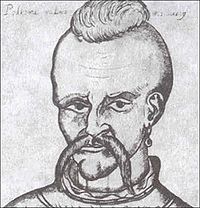 |
Ivan Pidkova, the first Hetman Hetman Hetman was the title of the second-highest military commander in 15th- to 18th-century Poland and the Grand Duchy of Lithuania, which together, from 1569 to 1795, comprised the Polish-Lithuanian Commonwealth, or Rzeczpospolita.... to be elected by the entire Sich Sich A sich is the administrative and military centre for Cossacks and especially the Zaporizhian Cossacks. It is derived from the Ukrainian word siktý, "to chop", meaning to clear a forest for an encampment, or to build a fortification with the trees that have been chopped down.The Zaporizhian Sich... , thus establishing the first direct democratic rule in modern Europe |
?-1578 | 1577 | 1578 |
| Ivan Orishevsky | ? | 1579 | 1591 | |
| Bogdan Mikoshinsky | ? | 1586 | 1594 | |
| Kryshtof Kosynsky | 1545–1593 | 1591 | 1593 | |
| Hryhory Loboda Hryhory Loboda Hryhory Loboda , was a Kosh Otaman of the Zaporizhian Host of Romanian descent. In 1594 and 1595 he and Severyn Nalyvaiko took part in the anti-Turkish campaign in Moldavia as allies of Rudolf II... |
?-1596 | 1593 | 1596 | |
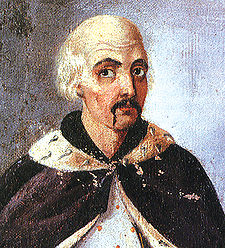 |
Severyn Nalyvaiko Severyn Nalyvaiko Severyn Nalyvaiko was a leader of the Ukrainian Cossacks who became a hero of Ukrainian folklore. He led the Nalyvaiko Uprising. The Decembrist poet Kondraty Ryleyev wrote a poem about him.-Biography:... |
?-1597 | 1596 | 1596 |
.jpg) |
Petro Konashevych-Sahaidachny | 1570–1622 | 1614 | 1622 |
| Mykhailo Doroshenko Mykhailo Doroshenko Mykhailo Doroshenko was the Hetman of the registered Ukrainian Cossacks from 1623–1628.He was elevated to the rank of Cossack colonel in 1616, and he was active in Petro Konashevych's wars against Muscovy. He personally participated in the Battle of Khotyn in 1621... |
?–1628 | 1623 | 1628 | |
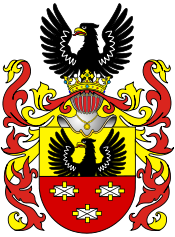 |
Hryhoriy Chorny, elected by Registered Cossacks Registered Cossacks Registered Cossacks is the term used for Cossacks formations of the Polish–Lithuanian Commonwealth armies.-Establishing:The registered cossacks were created on the King's edict of Sigismund II Augustus on June 5, 1572 confirming the orders of the Crown Hetman Jerzy Jazłowiecki. The first senior ... |
?-1630 | 1628 | 1630 |
| Taras Fedorovych Taras Fedorovych Taras Fedorovych was a prominent leader of the Dnieper Cossacks, a popular Hetman elected by unregistered Cossacks.... , elected by unregistered Cossacks |
?-1636 | 1629 | 1630 | |
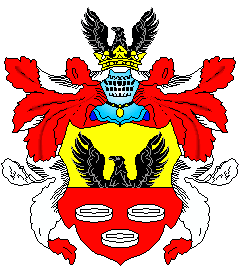 |
Ivan Sulyma Ivan Sulyma Ivan Sulyma was a Senior of Registered Cossacks in 1628-29 and a Kosh Otaman in 1630-35.-Life and Death:Son of Mykhailo Sulyma, Ivan came from a petty noble family. He was born in Rogoszcze... |
?–1635 | 1630 | 1635 |
| Dmytro Hunia Dmytro Hunia Dmytro Hunia was elected hetman of the Zaporozhian Host in 1638. He was one of the leaders of the Ostrzanin Uprising, a 1638 Cossack uprising against the Polish-Lithuanian Commonwealth. The rebellion was sparked by the Sejm act of the same year that declared that non-Registered Cossacks are equal... |
? | 1638 | 1638 | |
Hetmans of the Cossack state
Following the Khmelnytsky uprisingKhmelnytsky Uprising
The Khmelnytsky Uprising, was a Cossack rebellion in the Ukraine between the years 1648–1657 which turned into a Ukrainian war of liberation from Poland...
a new Cossack republic, the Hetmanate
Cossack Hetmanate
The Hetmanate or Zaporizhian Host was the Ruthenian Cossack state in the Central Ukraine between 1649 and 1782.The Hetmanate was founded by first Ukrainian hetman Bohdan Khmelnytsky during the Khmelnytsky Uprising . In 1654 it pledged its allegiance to Muscovy during the Council of Pereyaslav,...
, was formed.
| Portrait | Name | Born-Died | Ruled From | Ruled Until |
|---|---|---|---|---|
 |
Bohdan Khmelnytsky Bohdan Khmelnytsky Bohdan Zynoviy Mykhailovych Khmelnytsky was a hetman of the Zaporozhian Cossack Hetmanate of Polish–Lithuanian Commonwealth . He led an uprising against the Commonwealth and its magnates which resulted in the creation of a Cossack state... , the first sole ruler of the Ukrainian Cossack state who adopted the title of Hetman of the Zaporozhian Host |
1595—1657 | 1648 | 1657 |
 |
Ivan Bohun Ivan Bohun Ivan Bohun was a Ukrainian Cossack colonel. Close associate and friend of Bohdan Khmelnytsky, he opposed both the pacts with Polish-Lithuanian Commonwealth and with Tsardom of Russia .... , was the Acting Hetman Acting Hetman Acting Hetman was a title during the 17th, and 18th centuries, in the Cossack Hetmanate. The acting hetman was the governing authority in the Hetmanate temporarily substituted for the hetman. The acting hetman was appointed by the hetman himself, to perform the duties of the hetman when absent... during the Battle of Berestechko Battle of Berestechko The Battle of Berestechko was fought between rebellious Zaporozhian Cossacks, led by Hetman Bohdan Khmelnytsky, aided by their Crimean Tatar allies, and a Polish-Lithuanian Commonwealth army under King John II Casimir. It was the largest land battle of 17th century.Lasting from June 28 to June 30,... |
?-1664 | June 1651 | June 1651 |
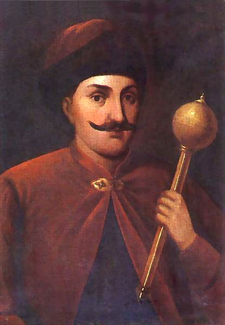 |
Ivan Vyhovsky Ivan Vyhovsky Ivan Vyhovsky was a hetman of the Ukrainian Cossacks during three years of the Russo-Polish War . He was the successor to the famous hetman and rebel leader Bohdan Khmelnytsky... , second Hetman of the Cossack Hetmanate Cossack Hetmanate The Hetmanate or Zaporizhian Host was the Ruthenian Cossack state in the Central Ukraine between 1649 and 1782.The Hetmanate was founded by first Ukrainian hetman Bohdan Khmelnytsky during the Khmelnytsky Uprising . In 1654 it pledged its allegiance to Muscovy during the Council of Pereyaslav,... , co-author of the Treaty of Hadiach Treaty of Hadiach The Treaty of Hadiach was a treaty signed on 16 September 1658 in Hadiach between representatives of the Polish-Lithuanian Commonwealth and Cossacks... signed in 1658, Voivode of Kiev (1660–1664) |
?-1664 | 21 October 1657 | 17 October 1659 |
 |
Yurii Khmelnytsky Yurii Khmelnytsky Yurii Khmelnytsky , younger son of the famous Ukrainian Hetman Bohdan Khmelnytsky and brother of Tymofiy Khmelnytsky, was a Zaporozhian Cossack political and military leader... , third Hetman of the Cossack Hetmanate who adopted the title of Hetman of the Zaporozhian Host and Prince of Sarmatia |
1641–1685 | 17 October 1659 | 1663 |
Hetmans during the Ruin
The RuinThe Ruin (Ukrainian history)
The Ruin is a period of Ukrainian history from the death of hetman Bohdan Khmelnitsky in 1657 and until ascension of hetman Ivan Mazepa in 1687. This period is characterised by continuous strife, civil war, and foreign intervention of Ukraine's neighbours...
(1660–1687) was a time in Ukrainian history when the country fell into disarray and chaos. Afterwards, the Cossack state emerged as a vassal of the Russian Empire
Russian Empire
The Russian Empire was a state that existed from 1721 until the Russian Revolution of 1917. It was the successor to the Tsardom of Russia and the predecessor of the Soviet Union...
. During this period a number of hetmans stayed in power for short periods of time and often controlled only parts of the country. Moreover the Treaty of Andrusovo
Treaty of Andrusovo
The Truce of Andrusovo was a thirteen and a half year truce, signed in 1667 between Tsardom of Russia and the Polish-Lithuanian Commonwealth, which were at war since 1654 over the territories of modern-day Ukraine and Belarus....
(1667) split the Cossack Hetmanate
Cossack Hetmanate
The Hetmanate or Zaporizhian Host was the Ruthenian Cossack state in the Central Ukraine between 1649 and 1782.The Hetmanate was founded by first Ukrainian hetman Bohdan Khmelnytsky during the Khmelnytsky Uprising . In 1654 it pledged its allegiance to Muscovy during the Council of Pereyaslav,...
along the Dnieper River
Dnieper River
The Dnieper River is one of the major rivers of Europe that flows from Russia, through Belarus and Ukraine, to the Black Sea.The total length is and has a drainage basin of .The river is noted for its dams and hydroelectric stations...
into Left-bank Ukraine
Left-bank Ukraine
Left-bank Ukraine is a historic name of the part of Ukraine on the left bank of the Dnieper River, comprising the modern-day oblasts of Chernihiv, Poltava and Sumy as well as the eastern parts of the Kiev and Cherkasy....
, which enjoyed a degree of autonomy within the Tsardom of Russia
Tsardom of Russia
The Tsardom of Russia was the name of the centralized Russian state from Ivan IV's assumption of the title of Tsar in 1547 till Peter the Great's foundation of the Russian Empire in 1721.From 1550 to 1700, Russia grew 35,000 km2 a year...
; and Right-bank Ukraine
Right-bank Ukraine
Right-bank Ukraine , a historical name of a part of Ukraine on the right bank of the Dnieper River, corresponding with modern-day oblasts of Volyn, Rivne, Vinnitsa, Zhytomyr, Kirovohrad and Kiev, as well as part of Cherkasy and Ternopil...
which remained part of the Polish-Lithuanian Commonwealth
Polish-Lithuanian Commonwealth
The Polish–Lithuanian Commonwealth was a dualistic state of Poland and Lithuania ruled by a common monarch. It was the largest and one of the most populous countries of 16th- and 17th‑century Europe with some and a multi-ethnic population of 11 million at its peak in the early 17th century...
, at times (1672–1699) occupied by the Ottoman Empire
Ottoman Empire
The Ottoman EmpireIt was usually referred to as the "Ottoman Empire", the "Turkish Empire", the "Ottoman Caliphate" or more commonly "Turkey" by its contemporaries...
.
Hetmans of Right-bank UkraineRight-bank UkraineRight-bank Ukraine , a historical name of a part of Ukraine on the right bank of the Dnieper River, corresponding with modern-day oblasts of Volyn, Rivne, Vinnitsa, Zhytomyr, Kirovohrad and Kiev, as well as part of Cherkasy and Ternopil...
| Portrait | Name | Born-Died | Ruled From | Ruled Until |
|---|---|---|---|---|
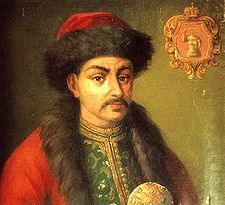 |
Pavlo Teteria Pavlo Teteria Pavlo Teteria was Hetman of Right-Bank Ukraine .Before his hetmancy he served in a number of high positions under Bohdan Khmelnytsky, and Ivan Vyhovsky.... , succeeded Yurii Khmelnytsky as the first ruler of Right-bank Ukraine |
? – 1670 | 1663 | 1665 |
 |
Petro Doroshenko Petro Doroshenko Petro Dorofeyevych Doroshenko was a Cossack political and military leader, Hetman of Right-bank Ukraine and a Russian voyevoda.-Earlier life:... , united Cossack state for a short period of time until accepting Ottoman Ottoman Empire The Ottoman EmpireIt was usually referred to as the "Ottoman Empire", the "Turkish Empire", the "Ottoman Caliphate" or more commonly "Turkey" by its contemporaries... suzerainty Suzerainty Suzerainty occurs where a region or people is a tributary to a more powerful entity which controls its foreign affairs while allowing the tributary vassal state some limited domestic autonomy. The dominant entity in the suzerainty relationship, or the more powerful entity itself, is called a... |
1627 – 19 November 1698 | 10 October 1665 | 19 September 1676 |
| Mykhailo Khanenko Mykhailo Khanenko Mykhailo Stepanovych Khanenko was a Ukrainian Cossack military leader, and nominal hetman of Right-bank Ukraine from 1669-74 in rivalry with Petro Doroshenko during The Ruin .... , proclaimed Hetman (1669) and nominated by the Polish authorities (1670) |
ca. 1620–1680 | 1669 | 1674 | |
 |
Yurii Khmelnytsky Yurii Khmelnytsky Yurii Khmelnytsky , younger son of the famous Ukrainian Hetman Bohdan Khmelnytsky and brother of Tymofiy Khmelnytsky, was a Zaporozhian Cossack political and military leader... , nominated by the Ottomans in 1678, and re-instaled by the Poles in 1683 |
1641–1685 | 1678 1683 |
1681 1683 |
| Stepan Kunytsky, nominated by the Polish authorities | ca. 1640–1684 | 1683 | 1684 | |
| Andriy Mohyla, nominated by the Polish authorities | ? – 1689 | 1684 | 1689 | |
| Samuel Samus, the Acting Hetman Acting Hetman Acting Hetman was a title during the 17th, and 18th centuries, in the Cossack Hetmanate. The acting hetman was the governing authority in the Hetmanate temporarily substituted for the hetman. The acting hetman was appointed by the hetman himself, to perform the duties of the hetman when absent... of the Right-bank Ukraine |
ca. 1688 – ca. 1713 | 1692 | 1704 | |
Hetmans of Left-bank UkraineLeft-bank UkraineLeft-bank Ukraine is a historic name of the part of Ukraine on the left bank of the Dnieper River, comprising the modern-day oblasts of Chernihiv, Poltava and Sumy as well as the eastern parts of the Kiev and Cherkasy....
| Portrait | Name | Born-Died | Ruled From | Ruled Until |
|---|---|---|---|---|
| | Yakym Somko Yakym Somko Yakym Somko , was a Ukrainian Cossack military leader of the Pereyaslav regiment and was the Acting Hetman of Left-bank Ukraine in 1660-1663, during The Ruin.... , the Acting Hetman Acting Hetman Acting Hetman was a title during the 17th, and 18th centuries, in the Cossack Hetmanate. The acting hetman was the governing authority in the Hetmanate temporarily substituted for the hetman. The acting hetman was appointed by the hetman himself, to perform the duties of the hetman when absent... of the Left-bank Ukraine |
?—28 September 1664 | 1660 | 1663 | |
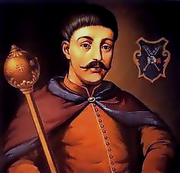 |
Ivan Briukhovetsky Ivan Briukhovetsky Ivan Briukhovetsky was a pro-Russian hetman of Left-Bank Ukraine from 1663 to 1668. For background see The Ruin... , was a pro-Russian hetman of Left-bank Ukraine |
?- 1668 | 1663 | 1668 |
 |
Petro Doroshenko Petro Doroshenko Petro Dorofeyevych Doroshenko was a Cossack political and military leader, Hetman of Right-bank Ukraine and a Russian voyevoda.-Earlier life:... |
1627 – 19 November 1698 | 9 June 1668 | 1669 |
 |
Demian Mnohohrishny Demian Mnohohrishny Demian Mnohohrishny was the Hetman of Left-bank Ukraine from 1669 to 1672. See The Ruin His surname literally means "of many sins".... , |
1630–1701 | 1669 | 1672 |
 |
Ivan Samoylovych Ivan Samoylovych Ivan Samoylovych was the Hetman of Left-bank Ukraine from 1672 to 1687. His term in office was marked by further incorporation of the Cossack Hetmanate into the nascent Russian Empire and by attempts to win the Right-bank Ukraine from Poland-Lithuania.... |
1630–1690 | 1672 | 1687 |
Hetmans after the Ruin and reunification of Ukraine (1687–1764/75)
| Portrait | Name | Born-Died | Ruled From | Ruled Until |
|---|---|---|---|---|
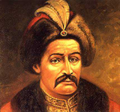 |
Ivan Mazepa Ivan Mazepa Ivan Stepanovych Mazepa , Cossack Hetman of the Hetmanate in Left-bank Ukraine, from 1687–1708. He was famous as a patron of the arts, and also played an important role in the Battle of Poltava where after learning of Peter I's intent to relieve him as acting Hetman of Ukraine and replace him... , Began a failed separatist movement against the majority of cossacks & Russia resulting in Ukraine's eventual annexation |
1639–1709 | 1687 | 1709 |
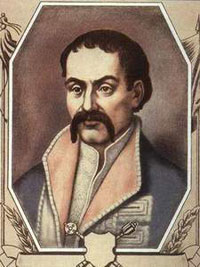 |
Pylyp Orlyk Pylyp Orlyk Pylyp Stepanovych Orlyk Pylyp Stepanovych Orlyk Pylyp Stepanovych Orlyk (born on October 11, 1672 in Kosuta, Ashmyany county, Grand Duchy of Lithuania (today in Vileyka Raion, Belarus), died on May 26, 1742 in Jassy, Principality of Moldavia (today Iaşi, Romania) was a Zaporozhian Cossack... , a very brief successor of Mazepa, an author of Constitution of Pylyp Orlyk, and the only hetman in exile |
1672–1742 | 1709 1710 in exile |
1709 1742 in exile |
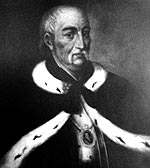 |
Ivan Skoropadsky Ivan Skoropadsky Ivan Skoropadsky was a Hetman of the Ukrainian Cossacks, and the successor to the famous Hetman Ivan Mazepa.- Biography:... , pro-Russian Cossack colonel who refused to join Ivan Mazepa in 1708 |
1646–1722 | 11 November 1708 | 14 July 1722 |
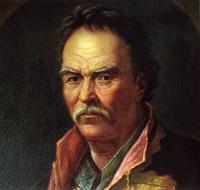 |
Pavlo Polubotok Pavlo Polubotok Pavlo Polubotok , was a Cossack political and military leader and Acting Hetman of the Left-bank Ukraine between 1722 and 1724.- Biography :... , served as the Acting Hetman Acting Hetman Acting Hetman was a title during the 17th, and 18th centuries, in the Cossack Hetmanate. The acting hetman was the governing authority in the Hetmanate temporarily substituted for the hetman. The acting hetman was appointed by the hetman himself, to perform the duties of the hetman when absent... |
1660?–1724 | 1722 | 1724 |
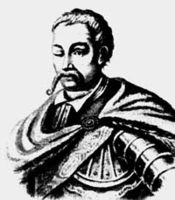 |
Danylo Apostol Danylo Apostol Danylo Apostol , was a Hetman of the Left-bank Ukraine and Ukrainian Cossack starshina.Born in a noble Cossack family of Moldavian boyar origin, Danylo Apostol was a prominent military leader, polkovnyk of the Myrhorod Regiment, and a participant in the Russian campaigns against the Ottoman... |
1654–1734 | 1727 | 1734 |
 |
Kirill Razumovsky Kirill Razumovsky Count Kirill Grigorievich Razumovsky was a Ukrainian Registered Cossack from the Kozelets regiment in north-eastern Ukraine, who served as the last Hetman of Left- and Right-Bank Ukraine until 1764; Razumovsky was subsequently elected Hetman of the sovereign Zaporozhian Host in 1759, a position... , after his rule the territory of Ukraine came under the direct governance of the Russian Empire Russian Empire The Russian Empire was a state that existed from 1721 until the Russian Revolution of 1917. It was the successor to the Tsardom of Russia and the predecessor of the Soviet Union... |
1728–1803 | 1750 | 1764 |
 |
Petro Kalnyshevsky Petro Kalnyshevsky Kalnyshevsky Petro was the last Koshovyi Otaman of the Zaporozhian Host, serving in 1762 and from 1765 to 1775. Kalnyshevsky was the Hero in the Russo-Turkish war of 1768-1774 and was honoured with a gold medal with brilliants for courage.Being the leader of the Zaporozhian Host, Kalnyshevsky... , the last Koshovyi Otaman Koshovyi Otaman Kosh Otaman was the highest military rank of the Zaporizhian Cossacks in the 16-18th centuries.-Overview:The otaman was elected by elders of the Zaporozhian Host. The position contained the highest military, administrative, and judicial powers. Until the establishment of the Cossack Hetmanate the... of the Zaporozhian Cossacks |
1691–1803 | 1765 | 1775 |
In the Russian Empire (1667/1793–1917) and Austria-Hungary (1526/1772–1918)
After the dissolution of the Cossack HetmanateCossack Hetmanate
The Hetmanate or Zaporizhian Host was the Ruthenian Cossack state in the Central Ukraine between 1649 and 1782.The Hetmanate was founded by first Ukrainian hetman Bohdan Khmelnytsky during the Khmelnytsky Uprising . In 1654 it pledged its allegiance to Muscovy during the Council of Pereyaslav,...
, a new Malorossiyan
Little Russia
Little Russia , sometimes Little or Lesser Rus’ , is a historical political and geographical term in the Russian language referring to most of the territory of modern-day Ukraine before the 20th century. It is similar to the Polish term Małopolska of the Polish-Lithuanian Commonwealth...
collegium was established in 1764, and the Zaporozhian Host
Zaporozhian Host
The Zaporozhian Cossacks or simply Zaporozhians were Ukrainian Cossacks who lived beyond the rapids of the Dnieper river, the land also known as the Great Meadow in Central Ukraine...
was disbanded in 1775. As a result of the second and third Partitions of Poland
Partitions of Poland
The Partitions of Poland or Partitions of the Polish–Lithuanian Commonwealth took place in the second half of the 18th century and ended the existence of the Polish–Lithuanian Commonwealth, resulting in the elimination of sovereign Poland for 123 years...
in 1793 and 1795, eastern and central parts of Ukraine were incorporated directly into the Russian Empire
Russian Empire
The Russian Empire was a state that existed from 1721 until the Russian Revolution of 1917. It was the successor to the Tsardom of Russia and the predecessor of the Soviet Union...
. Western Ukraine was annexed into the Habsburg Monarchy
Habsburg Monarchy
The Habsburg Monarchy covered the territories ruled by the junior Austrian branch of the House of Habsburg , and then by the successor House of Habsburg-Lorraine , between 1526 and 1867/1918. The Imperial capital was Vienna, except from 1583 to 1611, when it was moved to Prague...
earlier, in the following order: Carpathian Ruthenia
Carpathian Ruthenia
Carpathian Ruthenia is a region in Eastern Europe, mostly located in western Ukraine's Zakarpattia Oblast , with smaller parts in easternmost Slovakia , Poland's Lemkovyna and Romanian Maramureş.It is...
(1526), Galicia (1772), and Bukovina
Bukovina
Bukovina is a historical region on the northern slopes of the northeastern Carpathian Mountains and the adjoining plains.-Name:The name Bukovina came into official use in 1775 with the region's annexation from the Principality of Moldavia to the possessions of the Habsburg Monarchy, which became...
(1775).
The Russian Empire existed until 1917, and the Dual Monarchy, Austria–Hungary, existed until 1918.
Ukrainian People's Republic (1917–1921)
The Ukrainian People's RepublicUkrainian People's Republic
The Ukrainian People's Republic or Ukrainian National Republic was a republic that was declared in part of the territory of modern Ukraine after the Russian Revolution, eventually headed by Symon Petliura.-Revolutionary Wave:...
(UNR, 1917–1921) was formed after the Russian Revolution of 1917
Russian Revolution of 1917
The Russian Revolution is the collective term for a series of revolutions in Russia in 1917, which destroyed the Tsarist autocracy and led to the creation of the Soviet Union. The Tsar was deposed and replaced by a provisional government in the first revolution of February 1917...
, and lasted until the Peace of Riga
Peace of Riga
The Peace of Riga, also known as the Treaty of Riga; was signed in Riga on 18 March 1921, between Poland, Soviet Russia and Soviet Ukraine. The treaty ended the Polish-Soviet War....
between Poland
Second Polish Republic
The Second Polish Republic, Second Commonwealth of Poland or interwar Poland refers to Poland between the two world wars; a period in Polish history in which Poland was restored as an independent state. Officially known as the Republic of Poland or the Commonwealth of Poland , the Polish state was...
and Soviet Russia in March 1921. The leadership title varied and, despite a rather widespread misconception, none of them had the official title of president.
Chairmen of the Central Council
The Central Council (Tsentral’na rada) was the representative body governing the UNR.| Portrait | Name | Born-Died | In Office From | In Office Until |
|---|---|---|---|---|
| Mykhailo Hrushevskyi | 1866–1934 | 27 March 1917 | 29 April 1918 | |
- Volodymyr Naumenko and Serhiy YefremovSerhiy YefremovSerhiy Yefremov was a Ukrainian literary journalist, historian, critic, political activist, statesman, and academician. He was a member of the Ukrainian Academy of Science and Shevchenko Scientific Society in Lviv...
(27–29 April 1917 (acting for HrushevskyMykhailo HrushevskyMykhailo Serhiyovych Hrushevsky was a Ukrainian academician, politician, historian, and statesman, one of the most important figures of the Ukrainian national revival of the early 20th century...
)
Hetman of the Ukrainian State
A very short lived Hetmanate was established by Pavlo Skoropadskyi in 1918.| Portrait | Name | Born-Died | In Office From | In Office Until |
|---|---|---|---|---|
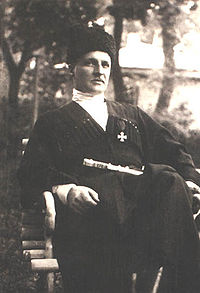 |
Pavlo Skoropadskyi | 1873–1945 | 29 April 1918 | 14 December 1918 |
Chairmen of the Directory
The Directorate of UkraineDirectorate of Ukraine
The Directorate, or Directory was a provisional revolutionary state committee of the Ukrainian National Republic, formed in 1918 by the Ukrainian National Union in rebellion against Skoropadsky's regime....
was a provisional council of the UNR formed after Skoropadskyi's Hetmanate fell apart. On 22 January 1919, the Act of Unification
Act Zluky
The Unification Act was an agreement signed on January 22, 1919 by the Ukrainian People's Republic and the West Ukrainian People's Republic on the St. Sophia Square in Kiev...
of the Ukrainian People's Republic
Ukrainian People's Republic
The Ukrainian People's Republic or Ukrainian National Republic was a republic that was declared in part of the territory of modern Ukraine after the Russian Revolution, eventually headed by Symon Petliura.-Revolutionary Wave:...
and the West Ukrainian People's Republic was passed. The text of the universal was made by the members of the Directory.
| Portrait | Name | Born-Died | In Office From | In Office Until |
|---|---|---|---|---|
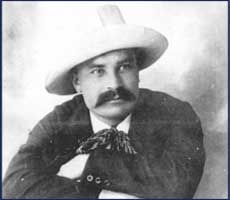 |
Volodymyr Vynnychenko Volodymyr Vynnychenko Volodymyr Kyrylovych Vynnychenko - Biography :Vynnychenko was born in Yelisavetgrad , the Kherson Governorate of the Russian Empire in a family of peasants. His father Kyrylo Vasyliovych Vynnychenko earlier in his life was a peasant-serf has moved from a village to the city of Yelisavetgrad where... |
1880–1951 | 14 December 1918 | 11 February 1919 |
 |
Symon Petliura | 1879–1926 | 11 February 1919 | 7 May 1921 |
West Ukrainian People's Republic (1918–1919)
The government of the West Ukrainian People's Republic (WUNR) was proclaimed on 19 October 1918. WUNR was united with the Ukrainian People's RepublicUkrainian People's Republic
The Ukrainian People's Republic or Ukrainian National Republic was a republic that was declared in part of the territory of modern Ukraine after the Russian Revolution, eventually headed by Symon Petliura.-Revolutionary Wave:...
on 22 January 1919, although it was mostly a symbolic act while the western Ukrainians retained their own Ukrainian Galician Army
Ukrainian Galician Army
Ukrainian Galician Army , was the Ukrainian military of the West Ukrainian National Republic during and after the Polish-Ukrainian War. -Military equipment:...
and government structure. After the Polish-Ukrainian War
Polish-Ukrainian War
The Polish–Ukrainian War of 1918 and 1919 was a conflict between the forces of the Second Polish Republic and West Ukrainian People's Republic for the control over Eastern Galicia after the dissolution of Austria-Hungary.-Background:...
(1918–1919), Poland took over most of territory of the West Ukrainian People's Republic by July 1919. Since November 1919, the government of the WUNR was in exile.
President of the Ukrainian National Republic
| Portrait | Name | Born-Died | In Office From | In Office Until |
|---|---|---|---|---|
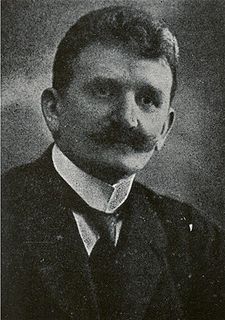 |
Yevhen Petrushevych Yevhen Petrushevych Yevhen Petrushevych was a Ukrainian lawyer, politician, and president of the Western Ukrainian National Republic formed after the collapse of the Austro-Hungarian empire in 1918.-Biography:He was born on June 3, 1863, in the town of Busk, of Galicia in the clerical... |
1863–1940 | 19 October 1918 | 15 March 1923 |
President of the Carpatho-Ukraine
| Portrait | Name | Born-Died | In Office From | In Office Until |
|---|---|---|---|---|
| Avgustyn Voloshyn | 1874–1945 | 15 March 1939 | 16 March 1939 |
Prime Minister of the Ukrainian State
| Portrait | Name | Born-Died | In Office From | In Office Until |
|---|---|---|---|---|
| Yaroslav Stetsko Yaroslav Stetsko Yaroslav Stetsko was the leader of the Bandera's Organization of Ukrainian Nationalists , from 1968 until death. In 1941, during Nazi Germany invasion into the Soviet Union he was self-proclaimed temporary head of the self-proclaimed Ukrainian statehood... |
1912–1986 | 30 June 1941 | 9 July 1941 |
Ukrainian Soviet Socialist Republic (1918/1921–1991)
Ukraine was incorporated into the Union of Soviet Socialist Republics on 30 December 1922.Secretaries of the Central Committee of the Communist Party (Bolsheviks) of Ukraine

- Mykola Oleksiiovych SkrypnykMykola SkrypnykMykola Oleksiyovych Skrypnyk was a Ukrainian Bolshevik leader who was a proponent of the Ukrainian Republic's independence, and led the cultural Ukrainization effort in Soviet Ukraine. When the policy was reversed and he was removed from his position, he committed suicide rather than be forced to...
(20 April – 26 May 1918) (Secretary of the Organizational Bureau) - Yurii Leonidovych PyatakovGeorgy PyatakovGeorgy Leonidovich Pyatakov was a Bolshevik revolutionary leader during the Russian Revolution, and member of the Left Opposition.Pyatakov was born August 6, 1890 in the settlement of the Mariinsky sugar factory which was owned by his father, an ethnic Russian, Leonid Timofeyevich Pyatakov.He...
(12 July – 9 September 1918) - Serafima Ilyinichna HopnerSerafima HopnerSerafima Hopner was a Bolshevik politician.Since 1905, she was a member, and then a secretary of Bolshevik party in Yekaterinoslav. In 1910-1917, she lived in emigration....
(9 September – 23 October 1918) - Emmanuil Ionovich KviringEmanuel KviringEmanuel Kwiring was a Soviet politician.Born into a German family in Friesenthal Emanuel Kwiring (Kviring) (13 September 1888, Friesenthal, Russian Empire - 26 November 1937, Moscow, Soviet Union) was a Soviet politician.Born into a German family in Friesenthal Emanuel Kwiring (Kviring) (13...
(23 October 1918 – 30 May 1919) - Stanislav Vikentevich KosiorStanislav KosiorStanislav Vikentyevich Kosior, sometimes spelled Kossior was one of three Kosior brothers, Polish-born Soviet politicians. He was General Secretary of the Ukrainian Communist Party, deputy prime minister of the USSR, and a member of the Politburo of the Communist Party of the Soviet Union...
(30 May – 10 December 1919) (1st time) - Vacant (10 December 1919 – January 1920)
- Rafail Borisovich Farbman (January – 23 March 1920) (acting)
- Nikolay Ilyich Nikolayev (23–25 March 1920)
- Stanislav Vikentevich KosiorStanislav KosiorStanislav Vikentyevich Kosior, sometimes spelled Kossior was one of three Kosior brothers, Polish-born Soviet politicians. He was General Secretary of the Ukrainian Communist Party, deputy prime minister of the USSR, and a member of the Politburo of the Communist Party of the Soviet Union...
(25 March – 23 November 1920) (2nd time)
First Secretary of the Central Committee
- Vyacheslav Mihailovich Molotov (23 November 1920 – 22 March 1921)
Executive Secretary of the Central Committee
- Feliks Yakovlevich KonFeliks KonFeliks Yakovlevich Kon was a Polish communist activist.-Career:Born in Warsaw, Kon's mother was Georgian and was brought up in Russia. He was trained as a historian and a journalist, but was involved in politics...
(22 March – 15 December 1921)
First Secretaries of the Communist Party
- Dmitry Zakharovich ManuilskyDmitry ManuilskyDmitriy Manuilsky, or Dmytro Zakharovych Manuilsky was an important Bolshevik. He was the son of an Orthodox priest from a Ukrainian village. After secondary school he enrolled in the University of St...
(15 December 1921 – 10 April 1923) - Emmanuil Ionovich KviringEmanuel KviringEmanuel Kwiring was a Soviet politician.Born into a German family in Friesenthal Emanuel Kwiring (Kviring) (13 September 1888, Friesenthal, Russian Empire - 26 November 1937, Moscow, Soviet Union) was a Soviet politician.Born into a German family in Friesenthal Emanuel Kwiring (Kviring) (13...
(10 December 1923 – 20 March 1925)
General Secretaries of the Central Committee
- Emmanuil Ionovich KviringEmanuel KviringEmanuel Kwiring was a Soviet politician.Born into a German family in Friesenthal Emanuel Kwiring (Kviring) (13 September 1888, Friesenthal, Russian Empire - 26 November 1937, Moscow, Soviet Union) was a Soviet politician.Born into a German family in Friesenthal Emanuel Kwiring (Kviring) (13...
(20 March – 7 April 1925) - Lazar Moiseyevich KaganovichLazar KaganovichLazar Moiseyevich Kaganovich was a Soviet politician and administrator and one of the main associates of Joseph Stalin.-Early life:Kaganovich was born in 1893 to Jewish parents in the village of Kabany, Radomyshl uyezd, Kiev Governorate, Russian Empire...
(7 April 1925 – 14 July 1928) - Stanislav Vikentevich KosiorStanislav KosiorStanislav Vikentyevich Kosior, sometimes spelled Kossior was one of three Kosior brothers, Polish-born Soviet politicians. He was General Secretary of the Ukrainian Communist Party, deputy prime minister of the USSR, and a member of the Politburo of the Communist Party of the Soviet Union...
(14 July 1928 – 23 January 1934)
First Secretaries of the Central Committee

- Stanislav Vikentevich KosiorStanislav KosiorStanislav Vikentyevich Kosior, sometimes spelled Kossior was one of three Kosior brothers, Polish-born Soviet politicians. He was General Secretary of the Ukrainian Communist Party, deputy prime minister of the USSR, and a member of the Politburo of the Communist Party of the Soviet Union...
(23 January 1934 – 27 January 1938) - Nikita Sergeyevich KhrushchevNikita KhrushchevNikita Sergeyevich Khrushchev led the Soviet Union during part of the Cold War. He served as First Secretary of the Communist Party of the Soviet Union from 1953 to 1964, and as Chairman of the Council of Ministers, or Premier, from 1958 to 1964...
(27 January 1938 – 3 March 1947) (1st time, acting) (in Russian SFSR exile from 1941 until 1944) - Lazar Moiseyevich KaganovichLazar KaganovichLazar Moiseyevich Kaganovich was a Soviet politician and administrator and one of the main associates of Joseph Stalin.-Early life:Kaganovich was born in 1893 to Jewish parents in the village of Kabany, Radomyshl uyezd, Kiev Governorate, Russian Empire...
(3 March – 26 December 1947) (2nd time) - Nikita Sergeyevich KhrushchevNikita KhrushchevNikita Sergeyevich Khrushchev led the Soviet Union during part of the Cold War. He served as First Secretary of the Communist Party of the Soviet Union from 1953 to 1964, and as Chairman of the Council of Ministers, or Premier, from 1958 to 1964...
(26 December 1947 – 16 December 1949) (2nd time) - Leonid Georgyevich Melnikov (16 December 1949 – 4 June 1953)
- Aleksey Illarionovich Kirichenko (4 June 1953 – 26 December 1957)
- Nikolay Viktorovich PodgornyNikolai PodgornyNikolai Viktorovich Podgorny was a Soviet Ukrainian statesman during the Cold War. He served as First Secretary of the Central Committee of the Communist Party of Ukraine, or leader of the Ukrainian SSR, from 1957 to 1963 and as Chairman of the Presidium of the Supreme Soviet from 1965 to 1977...
(26 December 1957 – 2 July 1963) - Pyotr Yefimovich ShelestPetro ShelestPetro Yukhymovych Shelest was the First Secretary of the Communist party in the Ukrainian Soviet Socialist Republic Petro Yukhymovych Shelest (February 14, 1908 - January 22, 1996) was the First Secretary of the Communist party in the Ukrainian Soviet Socialist Republic Petro Yukhymovych Shelest...
(2 July 1963 -25 May 1972) - Vladimir Vasilyevich ShcherbitskyVolodymyr ShcherbytskyVolodymyr Vasylyovych Shcherbytsky was a Ukrainian and Soviet politician. He was a leader of the Communist Party of Ukraine from 1972 to 1989....
(25 May 1972 – 28 September 1989) - Vladimir Antonovich IvashkoVladimir IvashkoVladimir Antonovich Ivashko , was briefly the acting General Secretary of the Communist Party of the Soviet Union during the period from 24 August 1991 to 29 August 1991. On 24 August Mikhail Gorbachev resigned, and on 29 August the CPSU was suspended by the Supreme Soviet...
(28 September 1989 – 22 June 1990) - Stanislav Ivanovich Gurenko (22 June 1990 – 1 September 1991)
UkraineUkraineUkraine is a country in Eastern Europe. It has an area of 603,628 km², making it the second largest contiguous country on the European continent, after Russia...
(1991 – present)
On 5 July 1991, the Verkhovna RadaVerkhovna Rada
The Verkhovna Rada of Ukraine is Ukraine's parliament. The Verkhovna Rada is a unicameral parliament composed of 450 deputies, which is presided over by a chairman...
of the Ukrainian SSR passed a law establishing the post of the President of the Ukrainian SSR. The title was changed to the President of Ukraine upon the proclamation of independence (24 August 1991). The first election of the President of Ukraine was held on 1 December 1991.
Presidents
| # | President | Took office | Left office | Party | Term | |
|---|---|---|---|---|---|---|
| 1 |  |
Leonid Makarovych Kravchuk Leonid Kravchuk Leonid Makarovych Kravchuk is a Ukrainian politician, the first President of Ukraine serving from December 5, 1991 until his resignation on July 19, 1994, a former Chairman of the Verkhovna Rada and People's Deputy of Ukraine serving in the Social Democratic Party of Ukraine faction.After a... |
5 December 1991 Inauguration: 22 August 1992 |
19 July 1994 | Non-partisan | 1 Ukrainian presidential election, 1991 The Ukrainian presidential election, 1991 was the first presidential election held in Ukraine following independence from the Soviet Union. The election was contested on December 1, 1991, with all six candidates campaigning in support of Ukrainian independence... |
| 2 |  |
Leonid Danylovych Kuchma Leonid Kuchma Leonid Danylovych Kuchma was the second President of independent Ukraine from 19 July 1994, to 23 January 2005. Kuchma took office after winning the 1994 presidential election against his rival, incumbent Leonid Kravchuk... |
19 July 1994 | 14 November 1999 | Independent Independent (politician) In politics, an independent or non-party politician is an individual not affiliated to any political party. Independents may hold a centrist viewpoint between those of major political parties, a viewpoint more extreme than any major party, or they may have a viewpoint based on issues that they do... / Non-partisan |
2 Ukrainian presidential election, 1994 The Ukrainian presidential election, 1994 was held on June 26, 1994 and July 10, 1994. The presidential election was ahead of schedule, following a political compromise between the President and Parliament... |
| 14 November 1999 | 23 January 2005 | 3 Ukrainian presidential election, 1999 The Ukrainian presidential election, 1999 was a presidential election held in 1999 in Ukraine.There were 15 candidates originally with two withdrawing prior to election .... |
||||
| 3 |  |
Viktor Andriyovych Yushchenko Viktor Yushchenko Viktor Andriyovych Yushchenko is a former President of Ukraine. He took office on January 23, 2005, following a period of popular unrest known as the Orange Revolution... |
23 January 2005 | 25 February 2010 | People's Union "Our Ukraine" | 4 Ukrainian presidential election, 2004 The Ukrainian presidential election, 2004 was held on October 31, November 21 and December 26, 2004. The election was the fourth presidential election to take place in Ukraine following independence from the Soviet Union... |
| 4 | Viktor Fedorovych Yanukovych Viktor Yanukovych Viktor Fedorovych Yanukovych is a Ukrainian politician who has been the President of Ukraine since February 2010.Yanukovych served as the Governor of Donetsk Oblast from 1997 to 2002... |
25 February 2010 | Incumbent Incumbent The incumbent, in politics, is the existing holder of a political office. This term is usually used in reference to elections, in which races can often be defined as being between an incumbent and non-incumbent. For example, in the 2004 United States presidential election, George W... |
Non-partisan (Supported by Party of Regions Party of Regions The Party of Regions is an Ukrainian political party created on October 26, 1997 just prior to the 1998 Ukrainian parliamentary elections under the name of Party of Regional Revival of Ukraine. It was reformed later in 2001 when the party united with several others... ) |
5 Ukrainian presidential election, 2010 The Ukrainian presidential election of 2010 is Ukraine's fifth presidential election since declaring independence from the Soviet Union in 1991. The first round was held on January 17, 2010... |
See also
- ScythiaScythiaIn antiquity, Scythian or Scyths were terms used by the Greeks to refer to certain Iranian groups of horse-riding nomadic pastoralists who dwelt on the Pontic-Caspian steppe...
- Kings of Cimmerian BosporusKings of Cimmerian Bosporus-Later Rulers:* Genger ca. 1150 BC* ?* Franco* Esdron* Gelio* Basabiliano* Plaserion I* Plesron* Eliacor* Gaberiano* Plaserion II* Antenor-Migration to Ukraine:* Priam II* Helenos II* Plesron II* Basabiliano II* Alexander* Priam III...
- Kingdom of PontusKingdom of PontusThe Kingdom of Pontus or Pontic Empire was a state of Persian origin on the southern coast of the Black Sea. It was founded by Mithridates I in 291 BC and lasted until its conquest by the Roman Republic in 63 BC...
- GothsGothsThe Goths were an East Germanic tribe of Scandinavian origin whose two branches, the Visigoths and the Ostrogoths, played an important role in the fall of the Roman Empire and the emergence of Medieval Europe....
- HunsHunsThe Huns were a group of nomadic people who, appearing from east of the Volga River, migrated into Europe c. AD 370 and established the vast Hunnic Empire there. Since de Guignes linked them with the Xiongnu, who had been northern neighbours of China 300 years prior to the emergence of the Huns,...
, List of Hunnic rulers - BulgarsBulgarsThe Bulgars were a semi-nomadic who flourished in the Pontic Steppe and the Volga basin in the 7th century.The Bulgars emerge after the collapse of the Hunnic Empire in the 5th century....
- KhazarsKhazarsThe Khazars were semi-nomadic Turkic people who established one of the largest polities of medieval Eurasia, with the capital of Atil and territory comprising much of modern-day European Russia, western Kazakhstan, eastern Ukraine, Azerbaijan, large portions of the northern Caucasus , parts of...
, List of Khazar rulers, - List of Crimean khans
- List of rulers of Galicia and Volhynia
- List of Galician rulers
- List of national leaders of Ukraine
- President of UkrainePresident of UkrainePrior to the formation of the modern Ukrainian presidency, the previous Ukrainian head of state office was officially established in exile by Andriy Livytskyi. At first the de facto leader of nation was the president of the Central Rada at early years of the Ukrainian People's Republic, while the...
- Prime Minister of UkrainePrime Minister of UkraineThe Prime Minister of Ukraine is Ukraine's head of government presiding over the Cabinet of Ministers of Ukraine, which is the highest body of the executive branch of the Ukrainian government....

